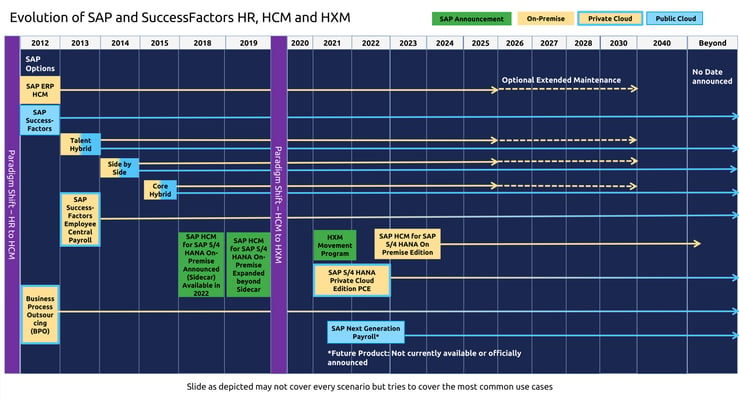-
SOFTWARE
SOFTWARESAP HCM & PayrollQuery Manager Query Manager Add-ons Document Builder Variance Monitor DSM for HCM HCM Productivity Suite FLOW GeoClockSAP Landscape & Test Data ManagementData Sync Manager (DSM) suite - System Builder/Shell Sync - Object Sync - Client Sync - Data Secure Archive CentralSupport & TrainingClient Central E-learning & trainingSAP Data Privacy & SecurityData Privacy suite - Data Secure - Data Disclose - Data Redact - Data Retain Soterion (GRC)
-
SERVICES
SERVICESSAP HCM & PayrollPRISM for HR & Payroll SAP SuccessFactors Integration monitoring Payroll reporting Report writingClient-specific DevelopmentCustom development SAP BTPSAP Landscape & Test Data ManagementPRISM Migrations to S/4HANA System Landscape Optimization (SLO) Managed data refresh servicesSAP Data Privacy & SecuritySAP data privacy assessment serviceMass data removal services Data privacy consultingCloud and Application Managed ServicesFunctional AMS Cloud management services Cloud migrations Basis managed services Private cloud hosting SAP on AWS SAP on Azure Premium Support Services RISE BRIDGE Managed Services
- All Solutions
- Request Estimate
-
Resources
Resources Blogs Read the latest updates on SAP SLO, SAP HCM, Data & Privacy, and Cloud Webinars Access expert insights in live and recorded webinars Video library Watch videos and improve your SAP knowledge
- About
Ultimate Guide: Journey from on-premise SAP HCM & Payroll to SAP SuccessFactors
Reviewing the journey and options for customers as they migrate from On-Premise SAP HCM and Payroll to SAP SuccessFactors and the cloud.
Danielle Larocca
Senior Vice-President of HCM Solutions Danielle Larocca has worked in the SAP HCM space for over 20 years. An SAP Mentor and featured speaker at numerous conferences, Danielle has authored four best-selling books on SAP, is the Technical Editor for the SAP Professional Journal, and often the Voice of the Expert on SAPInsider’s Ask the Expert series for HR.
In this guide, Danielle Larocca reviews the journey and options for customers as they migrate from On-Premise SAP HCM and Payroll to SAP SuccessFactors and the cloud. Danielle provides information on how SAP HCM has evolved with the latest technologies and enhancements, focusing on how SAP has adapted its landscape models and product offerings from on-premise to SAP SuccessFactors and the cloud to assist customers as they make their journey.
DOWNLOAD ULTIMATE GUIDE FAST FORWARD TO TODAY RECOMMENDED SOLUTIONS
1986
Business as usual
There was a long stretch of time where it was ‘business as usual’ for SAP HCM customers. Although some innovations were added, the core functionality for HR and Payroll largely stayed the same, as shown in the picture below.
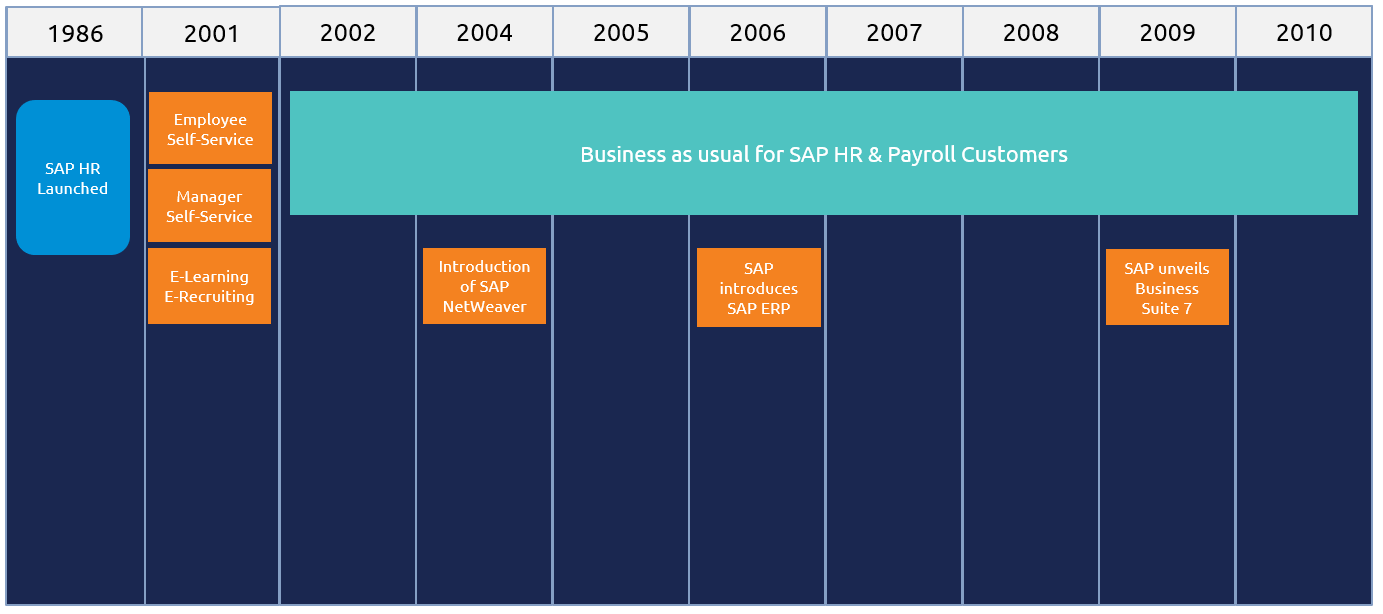
SAP acquires SuccessFactors
In late 2011, SAP acquired SuccessFactors which, at the time, was then the second largest cloud-based software solution next to Salesforce.com, with more than 3,500 customers and over 32 million users in 60 industries in over 165 countries in 35 languages.
The Journey from On-Premise SAP to SuccessFactors in the cloud
In 2012, SAP announced to its approximately 13,000 on-premise SAP HCM customers a planned movement to the cloud and a planned future cessation of its On-Premise HCM applications, including Payroll. When initially announced, customers were encouraged to journey to the cloud, adopting the SAP SuccessFactors cloud versions of the HCM solutions. SAP announced that customers had two landscape options to choose from: On-Premise SAP or Cloud, as included in their annual Roadmap update slide below.
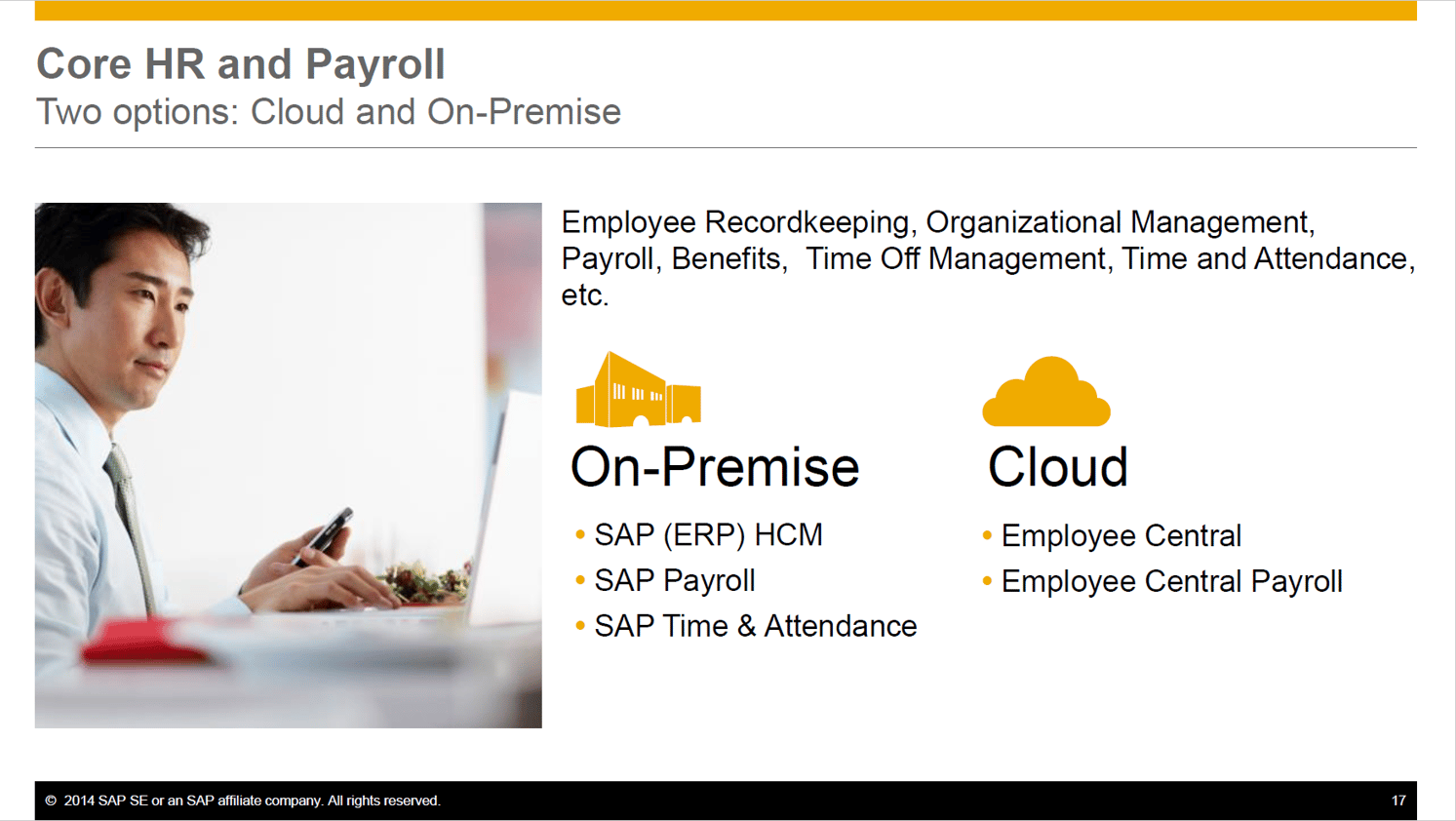
© SAP SuccessFactors Roadmap Update 2013 (2 options available)
2013
The SAP SuccessFactors journey begins
In 2013, customers were encouraged to begin their journey to the cloud and move from their SAP HCM On-Premise solutions to their cloud equivalents, as estimated in the picture below. The word ‘equivalents’ is not entirely accurate, as it is not a one-to-one mapping from the old modules to the new ones in SuccessFactors. Former SAP SuccessFactors CEO Mike Ettling advised customers that the shift from SAP to SuccessFactors is not a simple swap, stating “...any customer who goes into the exercise of considering swapping On-Premise with SuccessFactors as a like-for-like exercise is going to be very disappointed; the solutions are designed for different purposes.”
This is not a simple swap of modules, but rather a shift from a customized system to one designed leveraging standardization and best practice. In the early days since the acquisition, it was announced that partners would be leveraged to handle any functionality not currently available in the SuccessFactors solution, as shown below.
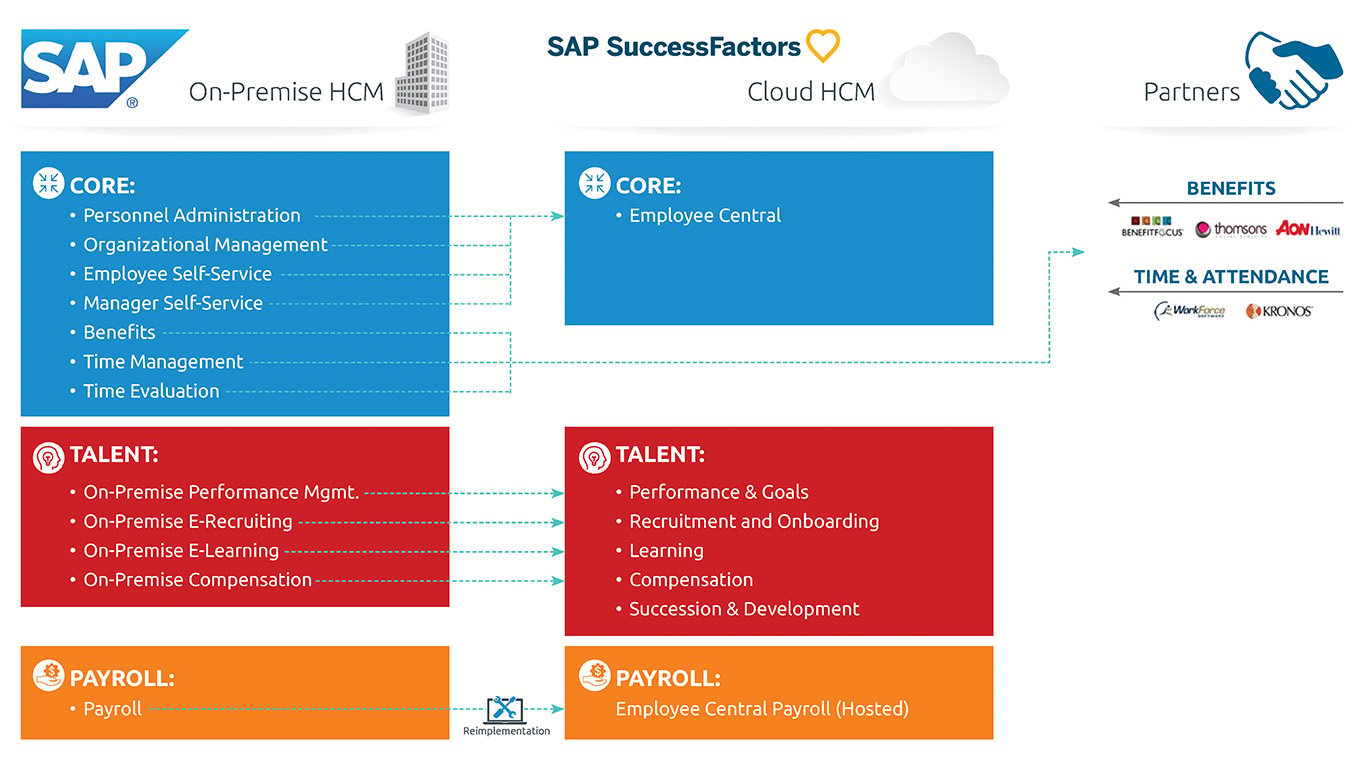
SAP SuccessFactors Landscape 2013
To explain how this missing functionality would be addressed, SAP shared the slide below showing that key pieces of functionality not available in SuccessFactors could be obtained via integration with Partners including Benefits and Time and Attendance Management.
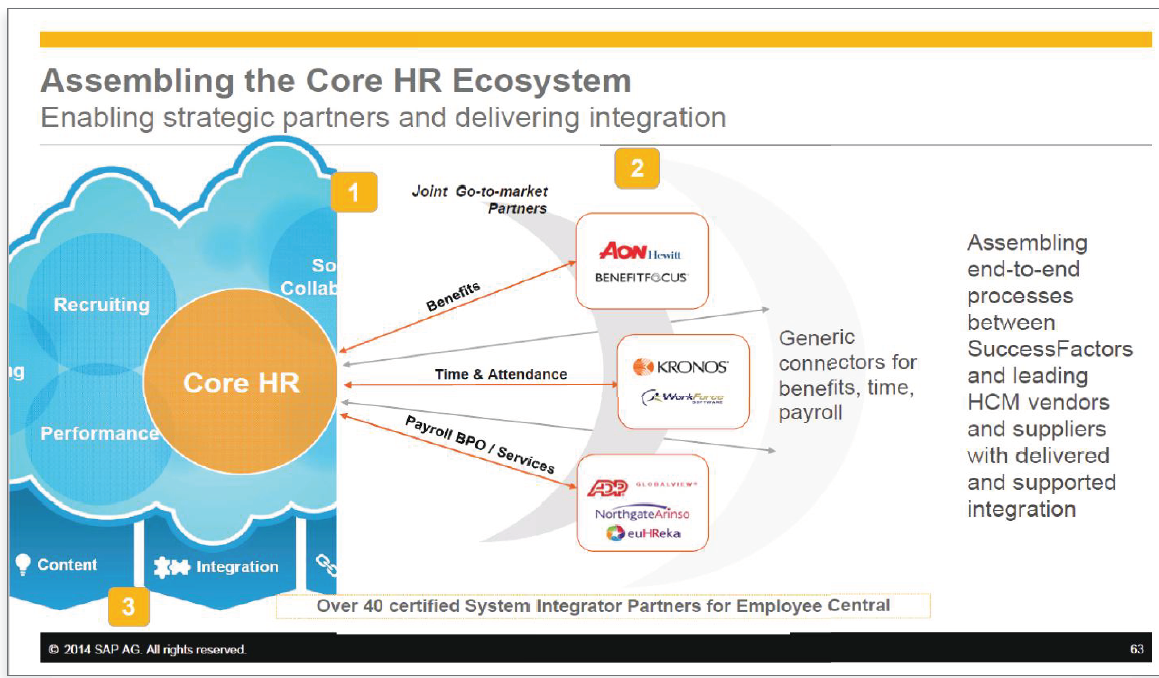
© SAP SuccessFactors Roadmap Update 2014 (Partner Integration)
3 Options for SAP SuccessFactors customers
The first customers to make the transition from SAP to SuccessFactors often did so focusing on the Talent modules (Recruitment and Learning for example), as their reputation for performance, user experience and success outweighed their SAP On-Premise counterparts and were often based on best of breed solutions. SAP also encouraged customers to start with an existing pain point in their organization which often concerned these talent areas.
Because of this migration to the talent modules, SAP created a new landscape model called the Talent Hybrid to categorize these customers as part of their cloud revenue. SAP then had three options: Customers were classified as On-Premise SAP, Full Cloud or the Talent Hybrid model, as shown in their Roadmap update shown below.
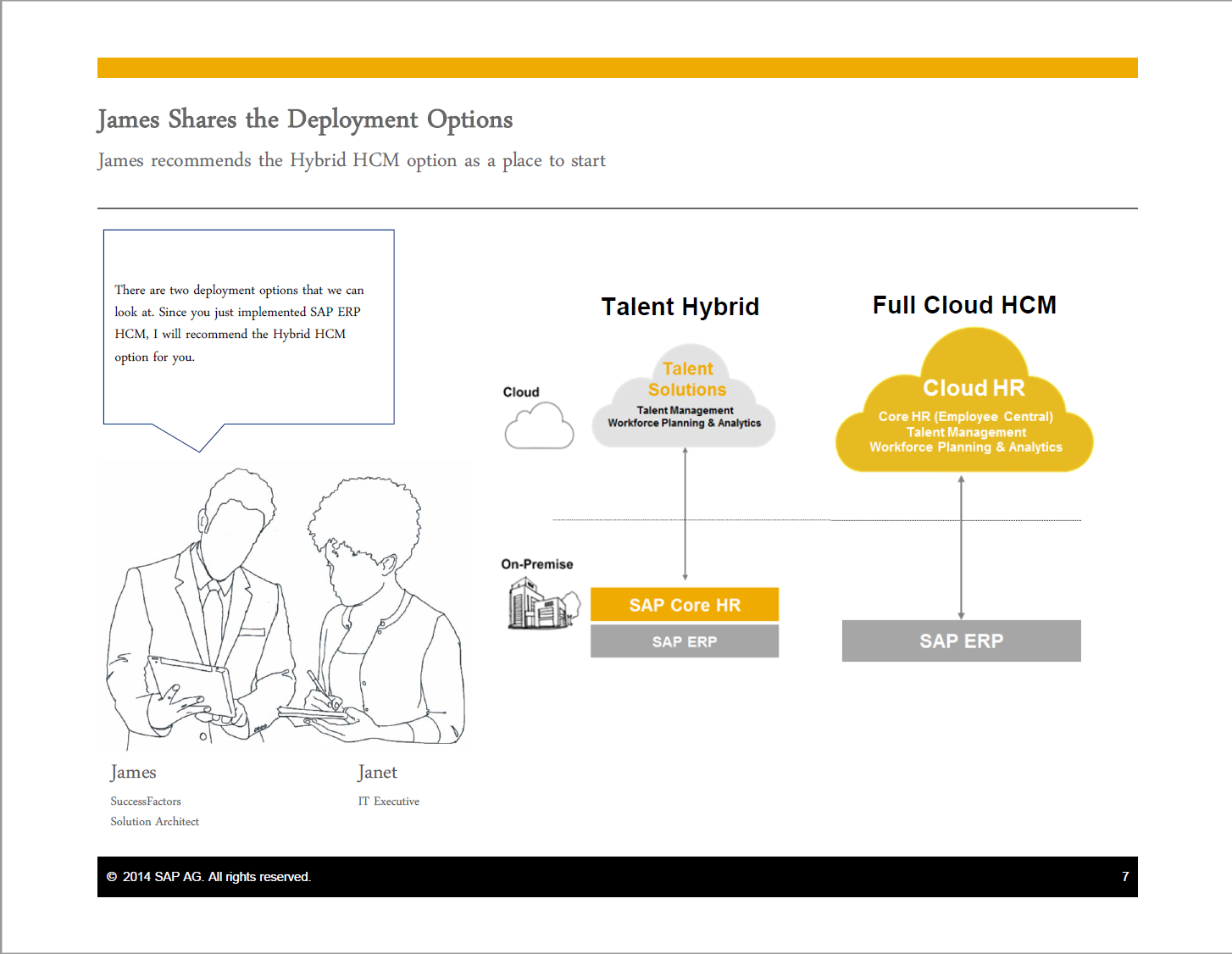
© SAP SuccessFactors Roadmap Update 2014 (3 options available)
This Talent Hybrid scenario accounted for those customers who still used SAP On-Premise for core HR but moved at least one Talent module to the cloud. The adoption of cloud technology appeared to be slower than anticipated after its announcement in 2012, and the guaranteed support date of year-end 2015 date was extended to 2020, and then extended again to 2025.

4 Options for SAP SuccessFactors customers
In 2014, a fourth model was added to account for customers who kept their SAP HCM On-Premise but who also deployed SAP SuccessFactors Employee Central for at least one division or region or country in their organization. This new landscape model was called Side-by-Side (originally called two-tier), as shown in SAP’s Roadmap update in late 2014, shown below.
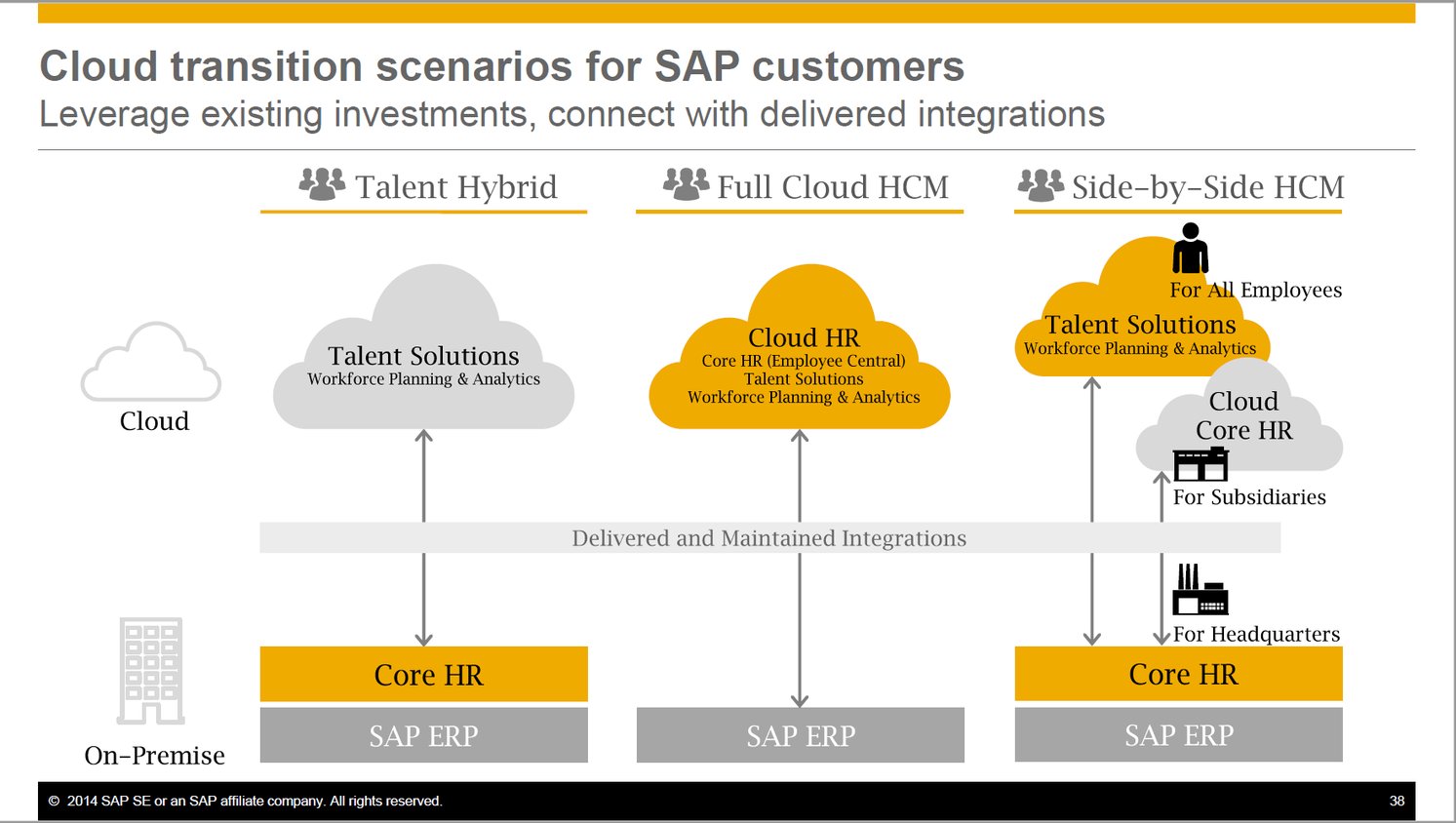
© SAP SuccessFactors Roadmap Update (4 options available)
This model allowed companies to keep their beloved SAP On-Premise solution as is, while using SuccessFactors Employee Central for new implementations of smaller regions or divisions giving them the opportunity to see the full power of the SuccessFactors Employee Central solution. At the conclusion of 2014 there were four options for customers: On-Premise, Talent Hybrid, Side-by-Side and Full Cloud.
The migration of SAP’s existing HCM customers, however, continued to be slow. I suspect much of it had to do with the perceived loss of functionality of moving to Employee Central or Employee Central Payroll, because a few of the core modules in SAP were not yet available in SuccessFactors, and customers had to leverage partners for the missing functionality like Time and Benefits. SAP SuccessFactors has made progress on this including the launch of Employee Central Time, and as of 2019, SAP now details which functionality is available within SAP SuccessFactors and which is managed via a partner integration as shown in the slide below.
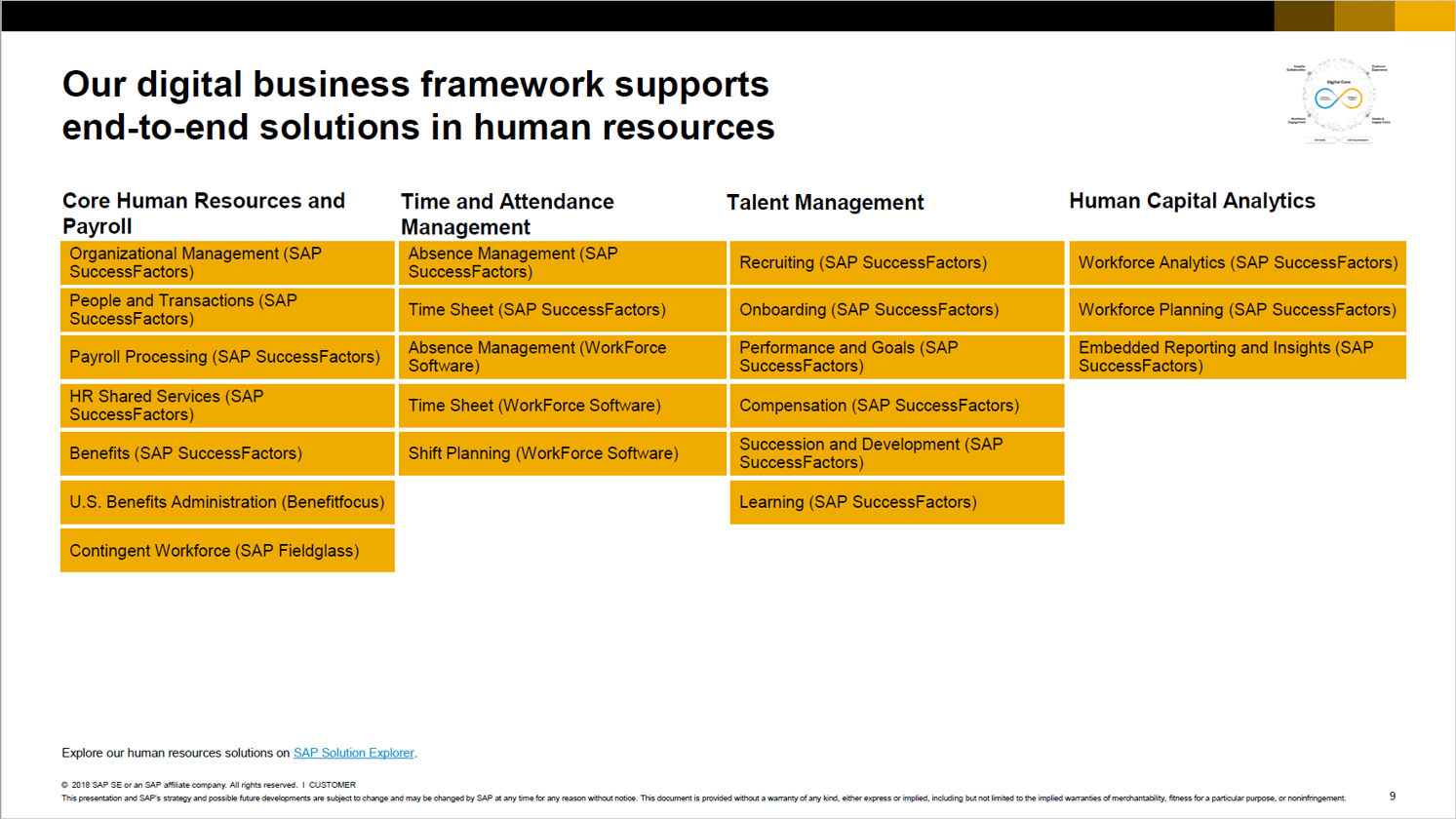
© SAP SuccessFactors Roadmap Update (Partner Integration)
New customers, not currently on the SAP HCM platform, began implementing SAP SuccessFactors Employee Central. However, a large majority of existing SAP On-Premise customers opted not to move away from their On-Premise core HR, which I suspect is because they did not wish to move their Benefits and Time systems to new integration partners. Additionally, SAP’s On-Premise Payroll customers were confused about what moving to SuccessFactors Employee Central Payroll would entail. Let’s take a moment to talk about Employee Central Payroll.
Payroll Options in SAP and SAP SuccessFactors
It appeared that SAP’s approximately 9,000 On-Premise Payroll customers were most reluctant to move to the SuccessFactors version of Payroll. I speculate that there are many explanations for this, including the large investment many companies made to customize their On-Premise Payroll, the detailed complexities of its integration with other systems for the processing of Benefits and Time, and their concerns about the overall maturity of the cloud counterpart referred to as SAP SuccessFactors Employee Central Payroll.
Part of the confusion is that SAP SuccessFactors Employee Central Payroll is not a new payroll solution; rather SAP has leveraged the existing world-class multinational SAP On-Premise Payroll and has transitioned it to a ‘hosted Cloud’ environment. The core engine of Employee Central Payroll is the same as the SAP On-Premise payroll engine; however from a development, support and licensing perspective it is designated as a separate product.
No-customization methodology?
Anyone familiar with SAP, including SAP Payroll, knows that SAP has been a system that is completely customizable, and each customer has painstakingly designed the system (including its time and benefits functionality) to support their unique business processes and needs. This often translates to many customizations, user exits, custom infotypes and objects etc. In contrast, however, in line with the overall Software as a Service (SaaS) mentality, SuccessFactors is based on a best-practice methodology which is not designed to necessarily accommodate unique customizations. This would mean that existing SAP On-Premise Payroll customers wishing to move to SAP SuccessFactors Employee Central Payroll not only needed to implement partner technology, like Workforce for Time data and Benefitfocus for benefits, but they also would need to reimplement and streamline their SAP Payroll to align with a higher level of standardization compared to the On-Premise payroll solution. For example, customers moving to Employee Central Payroll are not permitted to make core modifications or changes to enhancement spots. At the end of 2018, the marketing has since shifted to say that the ideal customers for Employee Central Payroll are often those organizations with greater than 5,000 employees without complex time or benefits processing.
Existing SAP On-Premise Payroll customers moving to SAP SuccessFactors Employee Central Payroll

Moving from SAP On-Premise Payroll to SuccessFactors Employee Central Payroll requires a Reimplementation
Existing SAP On-Premise Payroll customers wishing to move to SAP SuccessFactors Employee Central Payroll must complete the five steps below.
- Choose from two options for deployment: Customer-Managed or Partner-Managed
- Purchase a SuccessFactors Employee Central license
- Purchase a SuccessFactors Employee Central Payroll license
- Re-implement and simplify (remove customizations) in their existing SAP Payroll
- Build integrations (as needed) to partners for Time and/or Benefits processing.
Why move to SAP SuccessFactors Employee Central Payroll?
One of the primary motivations for movement to the cloud is to eliminate the need for a company to maintain its hardware and software and manage local installations of client server-based technology. Customers who elect to move to SAP SuccessFactors Employee Central Payroll are essentially leveraging that benefit from the cloud by allowing SAP to host their SAP database on a server for them to access via the internet. Another benefit of the SuccessFactors’ thinking is the adoption of best practice in the design of all aspects of human capital management, which often requires a standardization of processes to a certain extent. Standardization is not often the word that comes to mind when you think of SAP Payroll, as it is often one of the most customized modules in the SAP landscape.
Most On-Premise SAP core HCM solutions are customized to a large extent, to satisfy each organization’s unique individual business needs. SuccessFactors, particularly its core component of Employee Central, does not follow that philosophy. Instead it is based on best practice. When this ‘Best Practice’ methodology was first explained in detail back in 2014, with Mike Ettling proclaiming that “…customization was a dirty word…”, many companies simply pumped the brakes and refused to abandon their large investments in On-Premise SAP Payroll. This confusion in the marketplace about Employee Central Payroll was exacerbated by some bad press from some in the SAP sphere, encouraging Payroll customers to do nothing and hold tight. (More on the topic of Payroll follows further on this page).
5 Options for SAP SuccessFactors customers
It was at this point that SAP SuccessFactors added a new option to the mix, targeted specifically for Payroll.
SAP SuccessFactors launches a new offering: Managed Payroll
Added in 2015, the SAP SuccessFactors Managed Payroll offering was created to address the needs of customers that made a large investment in their SAP Payroll who wished to start their journey to the cloud but did not want to make any changes to their SAP On-Premise Payroll.
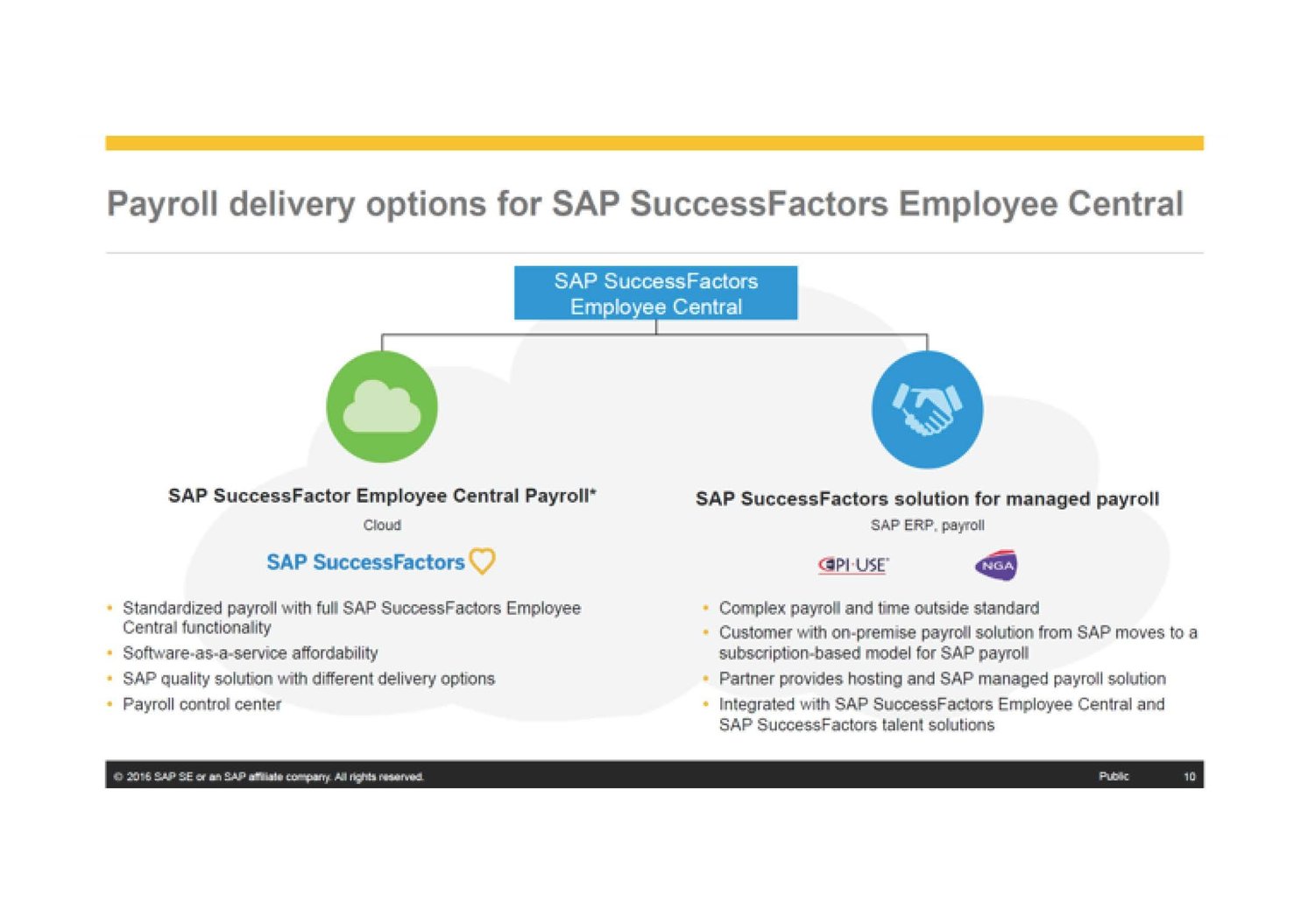
© SAP SuccessFactors Roadmap Update 2016 (Managed Payroll)
In my opinion, this new deployment and license option was created because movement to the cloud was slower than expected overall, and that reluctance was often driven by the approximately 9,000 Payroll customers who did not wish to re-implement and/or simplify their existing payroll while also building integrations as needed for partners for any missing functionality like Time or Benefits.
This new option, SAP SuccessFactors Managed Payroll, addressed the needs of customers that had made a large investment in their On-Premise SAP Payroll who do not wish to change it; however, they wanted to start their journey to the cloud.
This model allowed customers to make no changes to their existing SAP Payroll system or its processing. They simply allowed one of two certified partners to host it on their server. Because it is hosted on their server, it is considered a ‘hosted cloud’, just like the SAP ‘hosted Cloud’ option for Employee Central Payroll. The significant difference in this scenario is that customers did not have to make any changes to their customizations or their use of their existing Time or Benefits modules, and most importantly no reimplementation was required.
SAP handpicked the partner for this
SAP selected two vendors from the SAP HCM partner ecosphere who are solely allowed to offer the SAP SuccessFactors Managed payroll option. EPI-USE Labs is one of the selected partners based on our extensive expertise in this area, including our SAP HCM, automation and landscape transformation capabilities. Existing SAP On-Premise Payroll customers wishing to move to SAP SuccessFactors Managed Payroll must complete the three steps below:
- Purchase an SAP SuccessFactors Employee Central Payroll license and
- Select one of SAP’s two selected vendors
- That vendor will lift and shift that payroll, as is, to the “hosted cloud”.
The licensing for this option was done solely on SAP paper; however, the migration work is scoped directly with the selected vendor. This gives the customers the benefit of leveraging their On-Premise investment and all of its customizations while also enjoying the benefits of hosting and management in the cloud. EPI-USE Labs has performed many HCM carve-outs globally. This option, like On-Premise SAP includes guaranteed support through calendar year-end 2025, or 2030 for those customers on HANA. To account for this new model, SAP SuccessFactors offered a fifth landscape model called Core Hybrid, to the existing four: On-Premise, Talent Hybrid, Side-By-Side and Full Cloud.
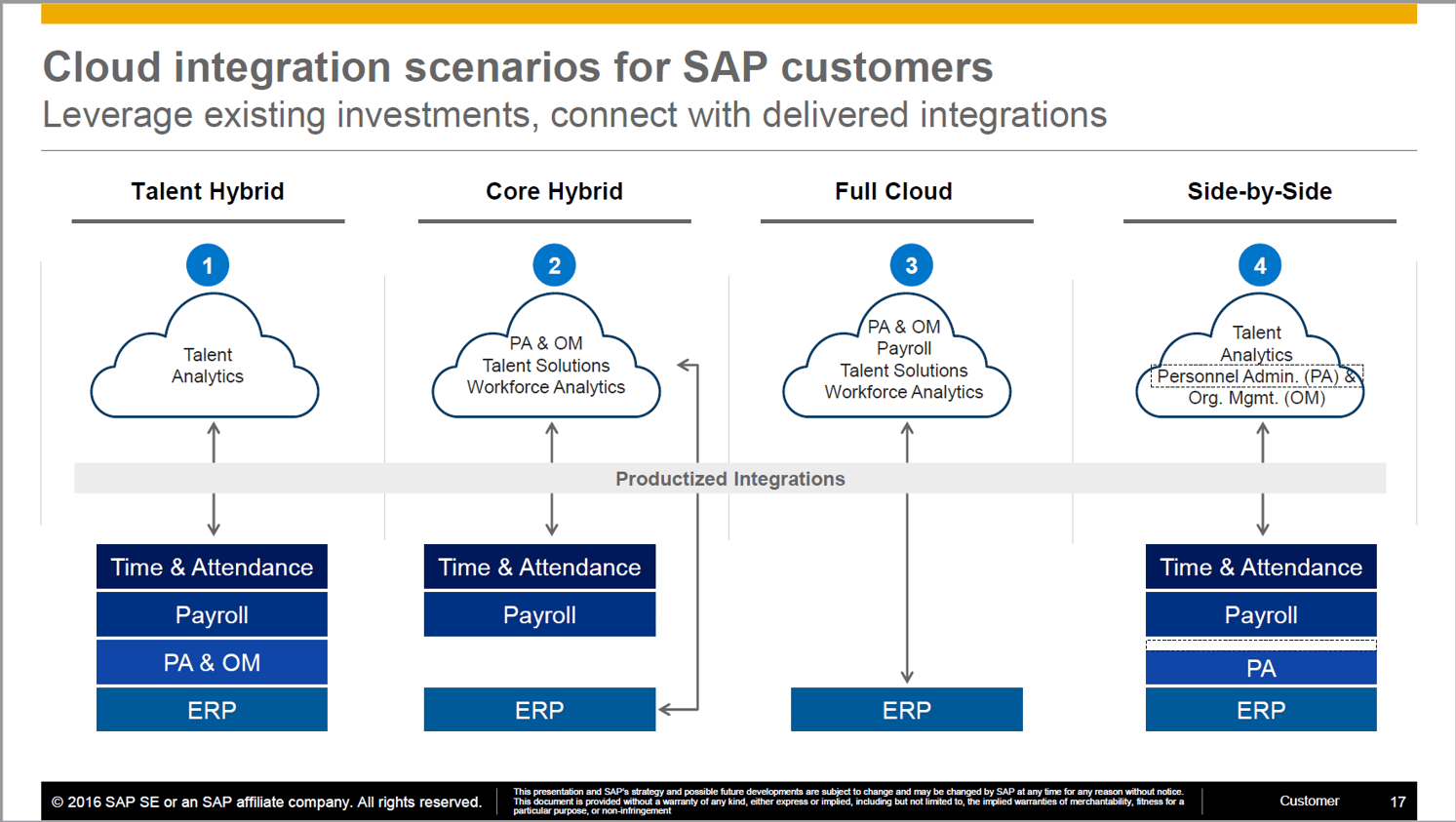
© SAP SuccessFactors Roadmap Update 2016 (5 options available)
Customers then had at least three options for what they could do with their SAP Payroll, as detailed in the picture below.
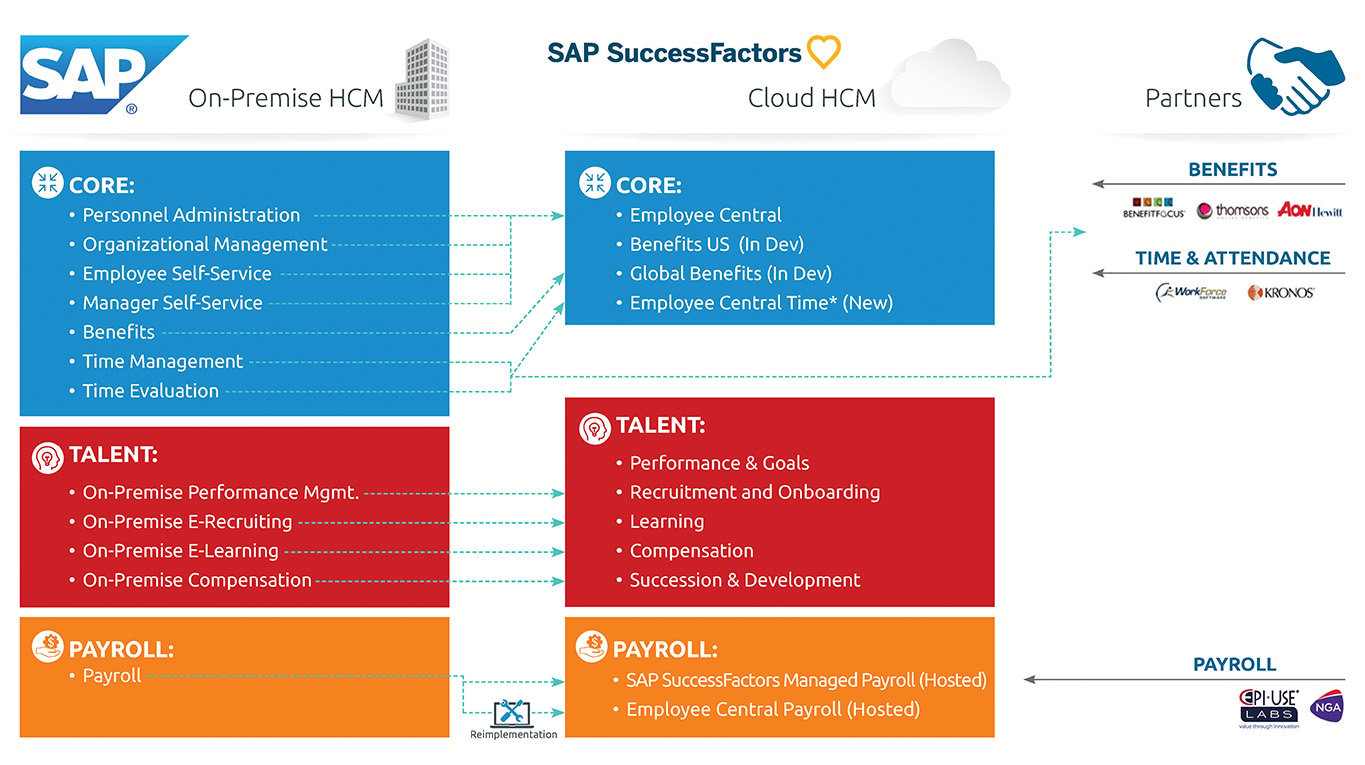
SAP SuccessFactors Landscape 2015
With five landscape options that evolved over a four-year period and three Payroll options, it’s fair to say that there was quite a bit of confusion in the marketplace. Adding to that confusion is that there are additional Payroll options available to customers which include working with a partner – often referred to as Business Process Outsourcing (BPO) – or even outsourcing the Payroll altogether either to a partner or another vendor as shown in the picture below.
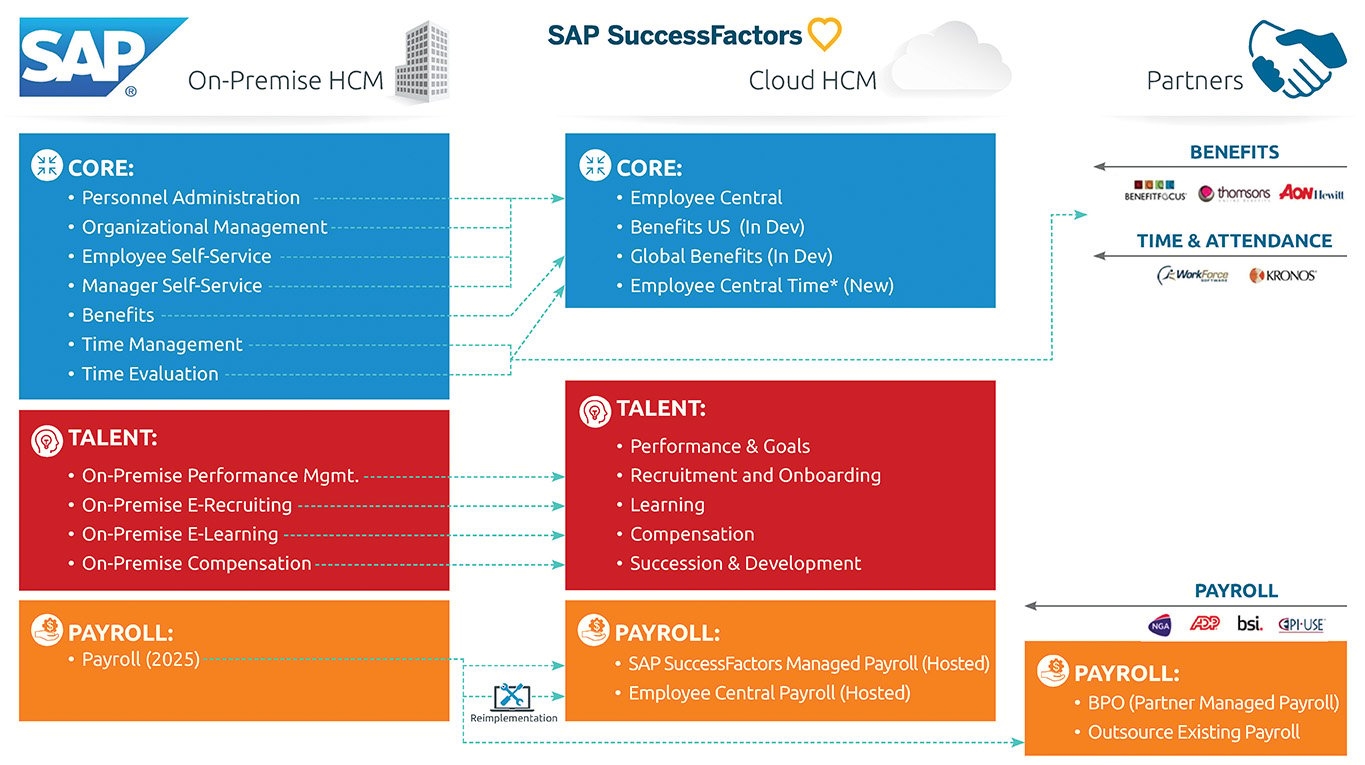
As customers evaluating these various options began their journeys to the cloud, many were still inquiring about the guaranteed end of support date of 2025 for the various options, as shown below.

As customers either began their investigation or actually commenced their cloud journeys, there were no big landscape related announcements in 2016 or 2017.

6 Options for SAP SuccessFactors customers
The guaranteed support date for On-Premise HCM was extended a couple of times giving customers ample time to migrate to the cloud. As mentioned earlier, I suspect that the largest resistance came from the approximately 9,000 Payroll customers who often asked SAP SuccessFactors to continue to extend the guaranteed support date beyond 2025.
SAP SuccessFactors launches a new offering: SAP HCM Side Car for S/4HANA
In January 2018 SAP SuccessFactors offered a new model, extending support for any existing On-Premise SAP HCM customer through calendar year-end 2030 if they upgrade any existing Business Suite license to SAP S/4HANA On-Premise. This brings the total number to six possible landscapes, as shown in the picture below. The new landscape option was titled the SAP HCM Side Car for S/4HANA or Side Car for short.
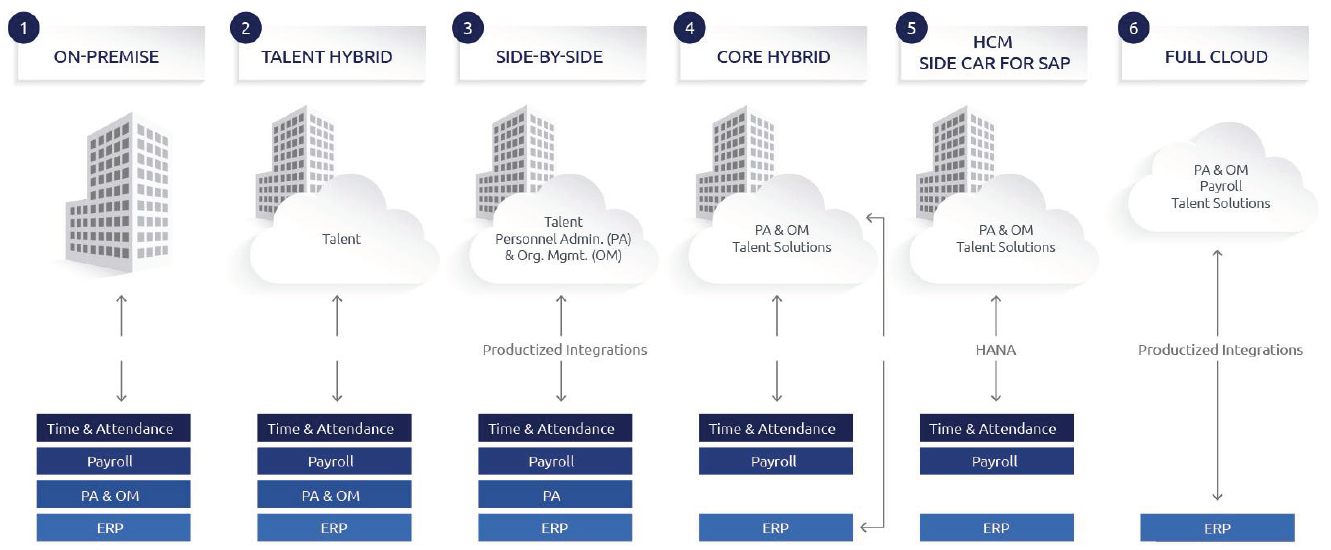
SAP SuccessFactors Landscape Models 2018
To include this new offering, I have updated my landscape model overview to include all six payroll options as detailed below. I have also added new partners and modules updated over the years to provide a complete picture of the landscape for customers as it appeared in 2018.
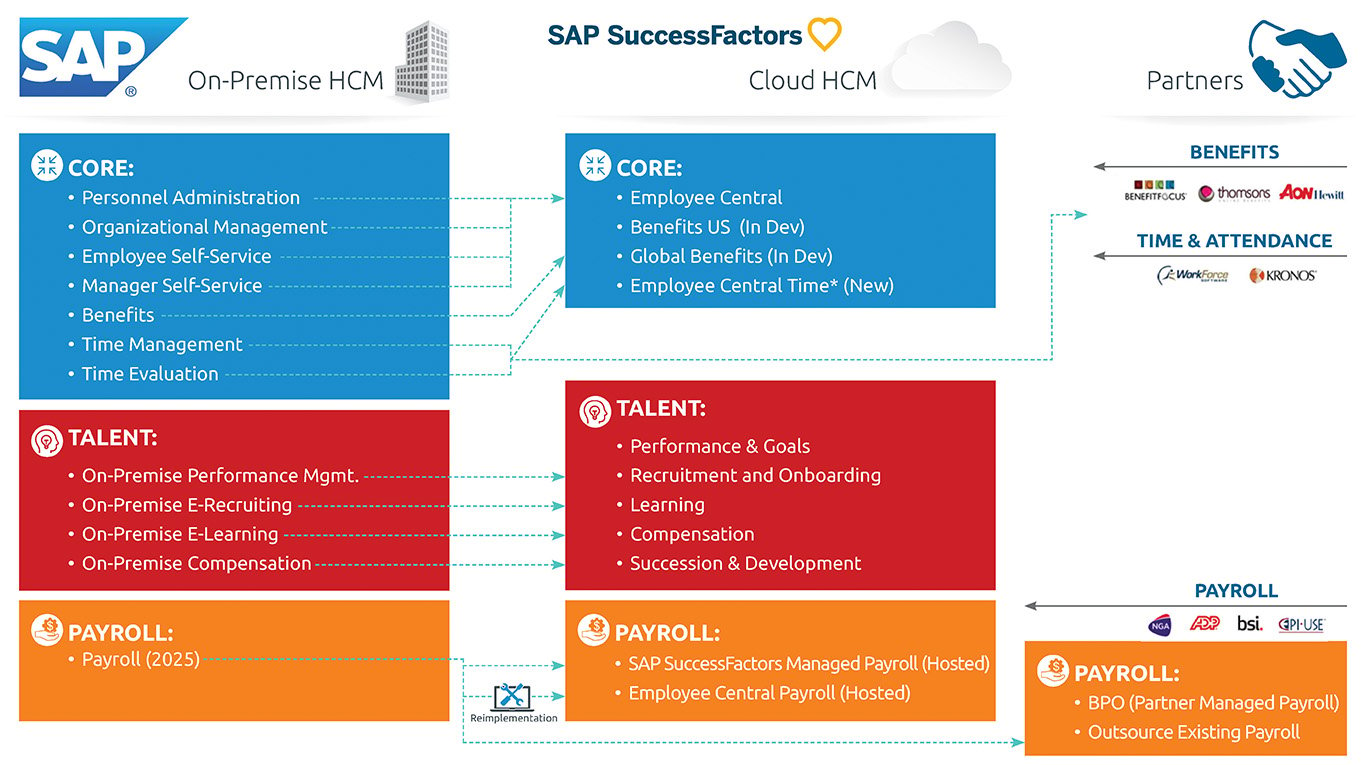
SAP SuccessFactors Landscape 2018
Payroll options for SAP SuccessFactors customers
There have been a few attempts to create decision trees to assist customers in making the appropriate decision for their payroll, including the samples from ASUG and SAP SuccessFactors, shown below:
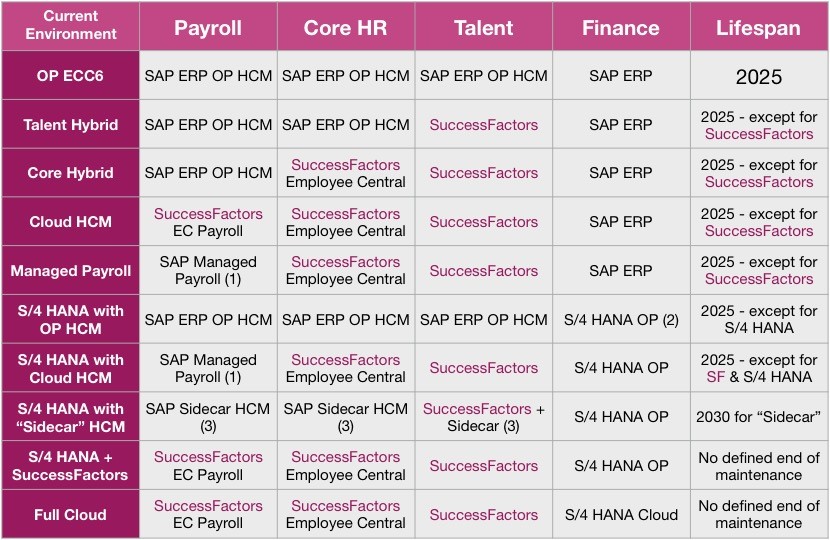 |
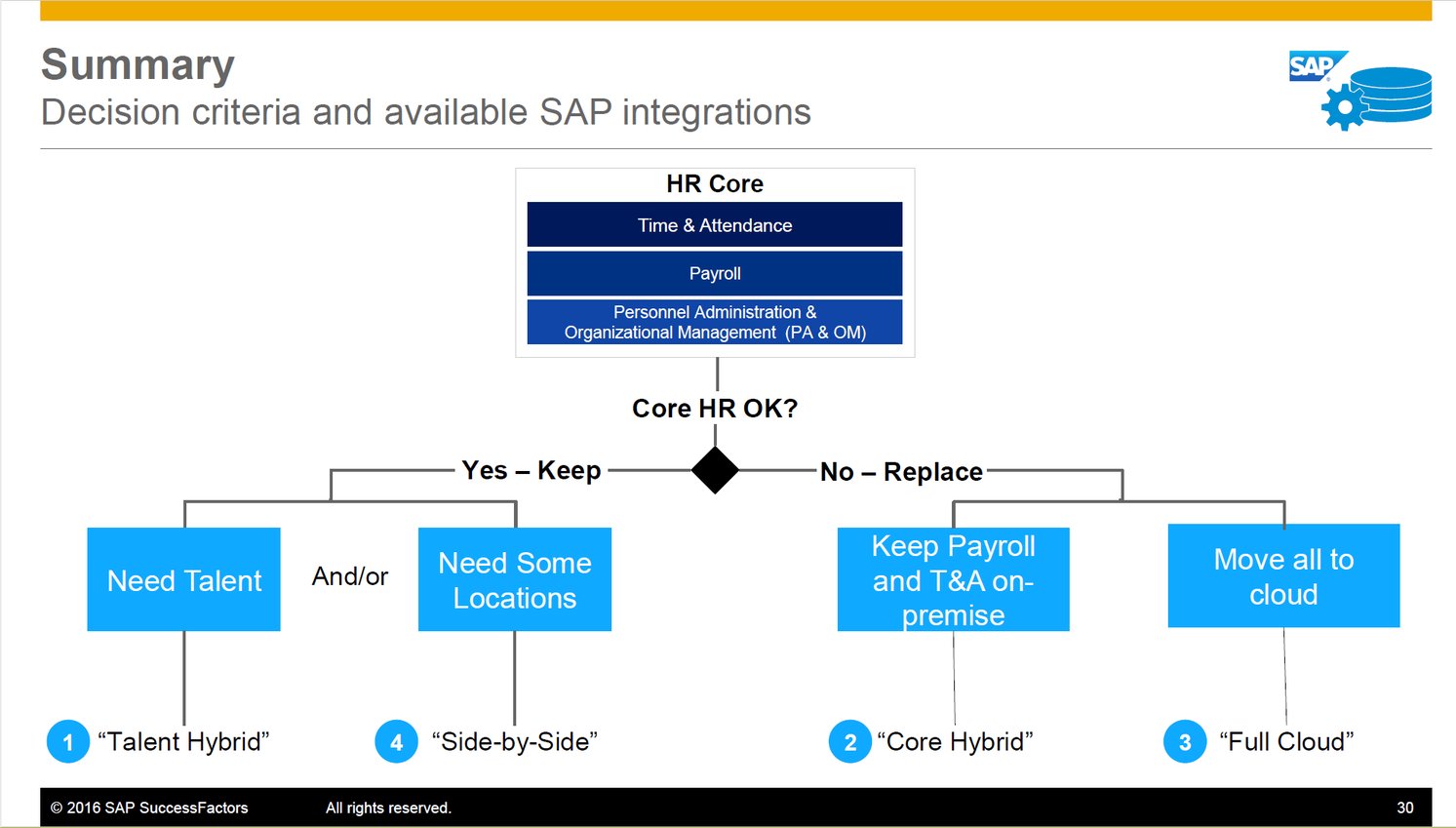 |
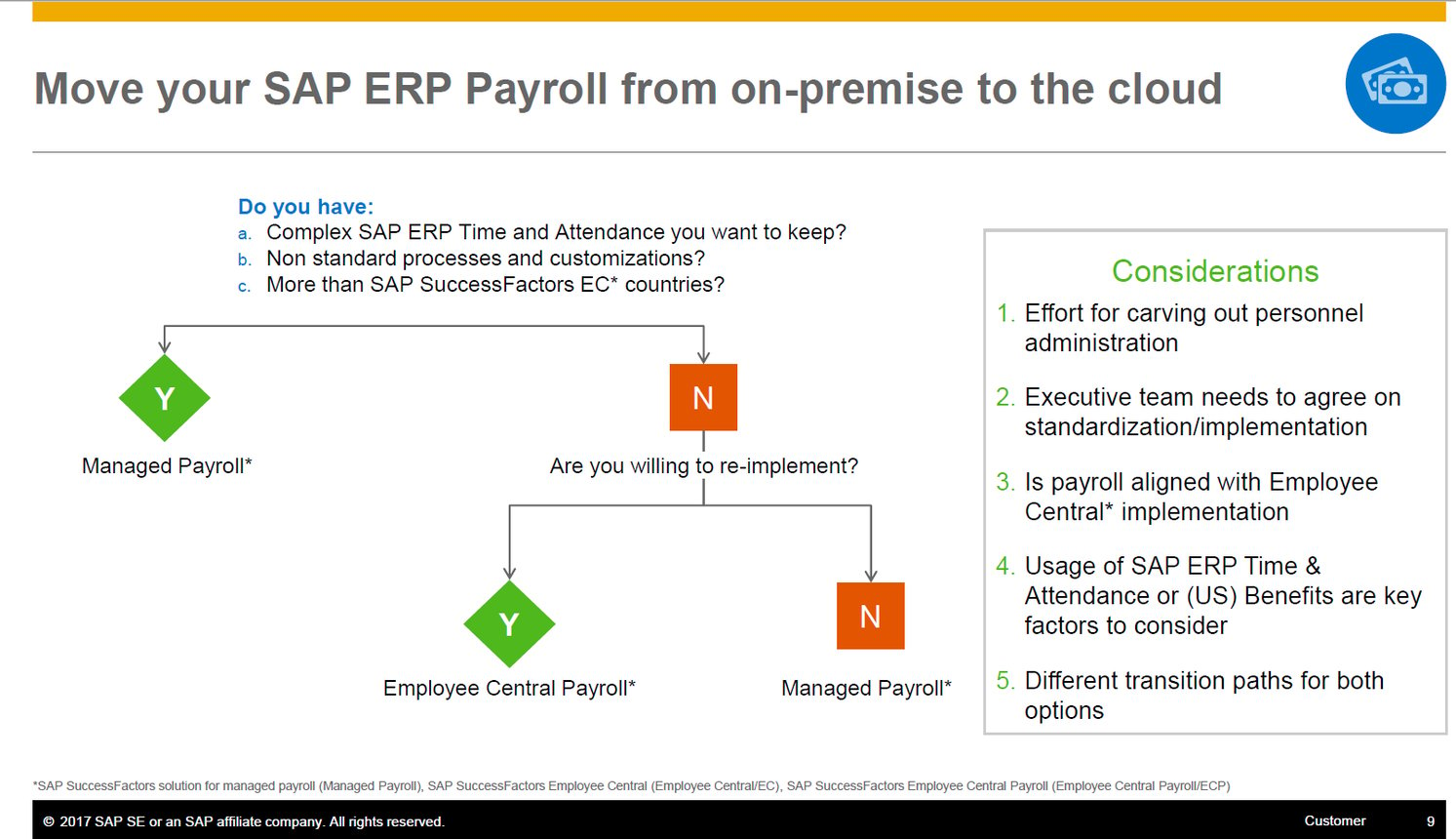 |
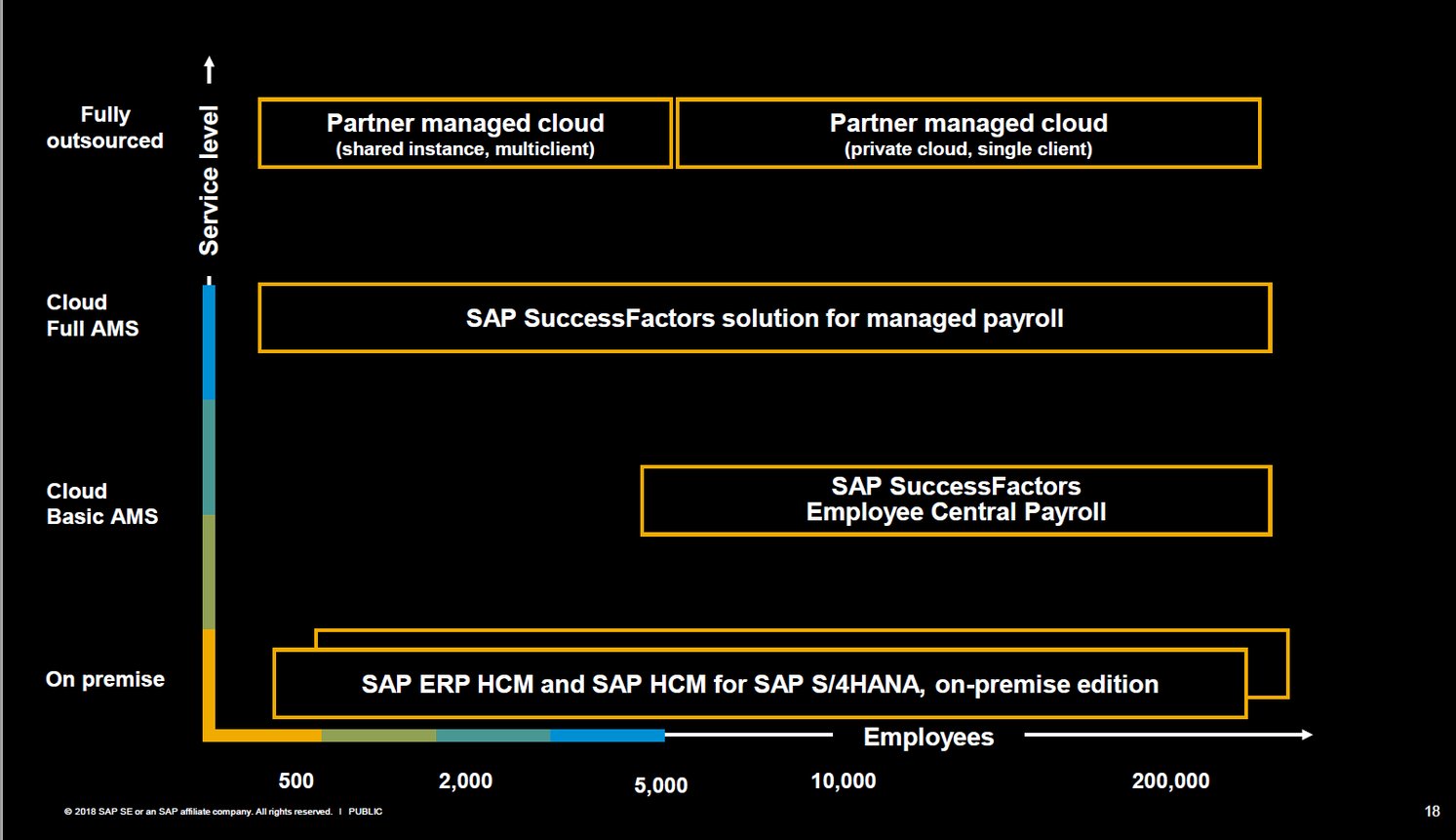 |
The latest version from SAP (February, 2019) is shown below:
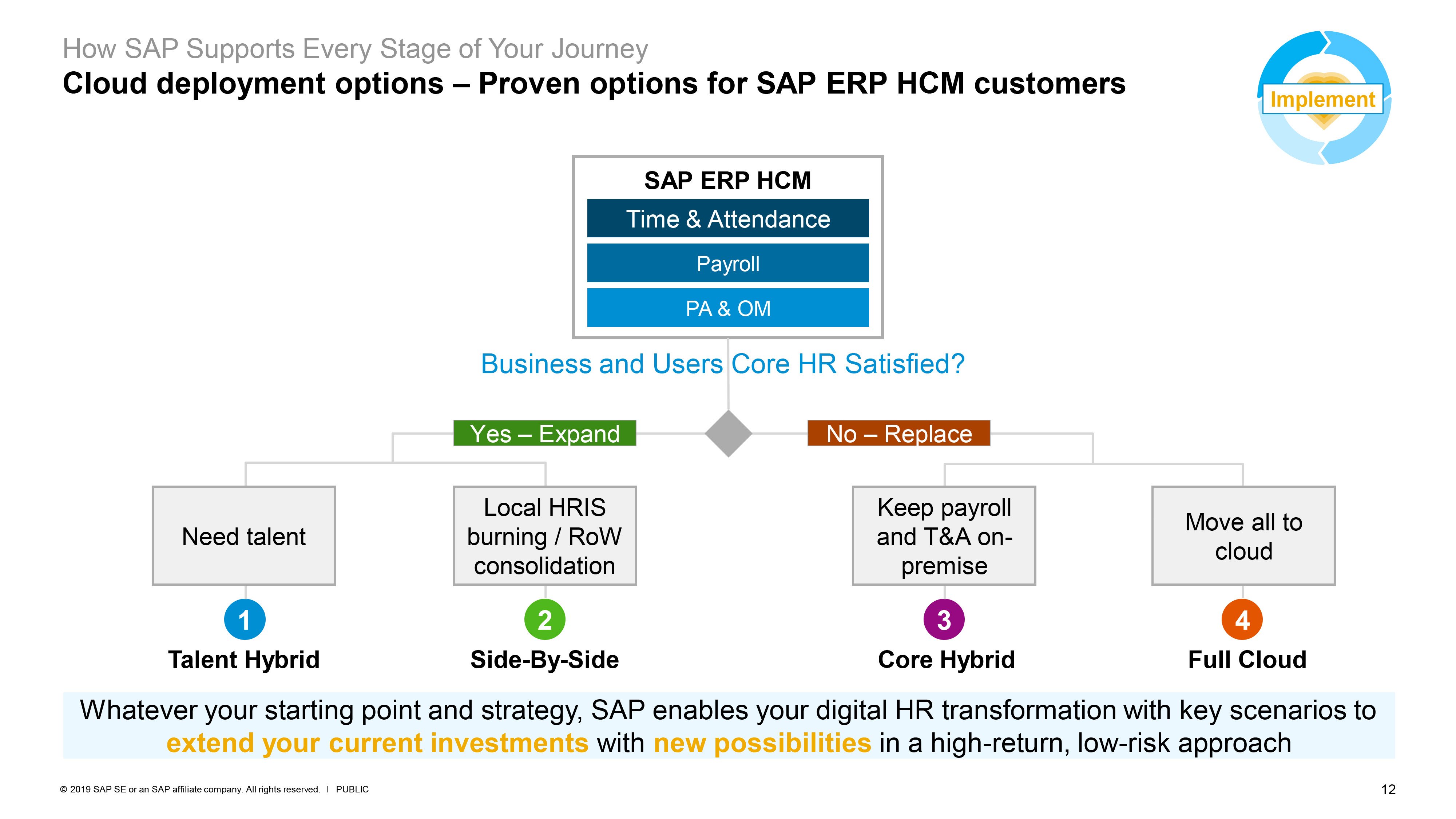 |
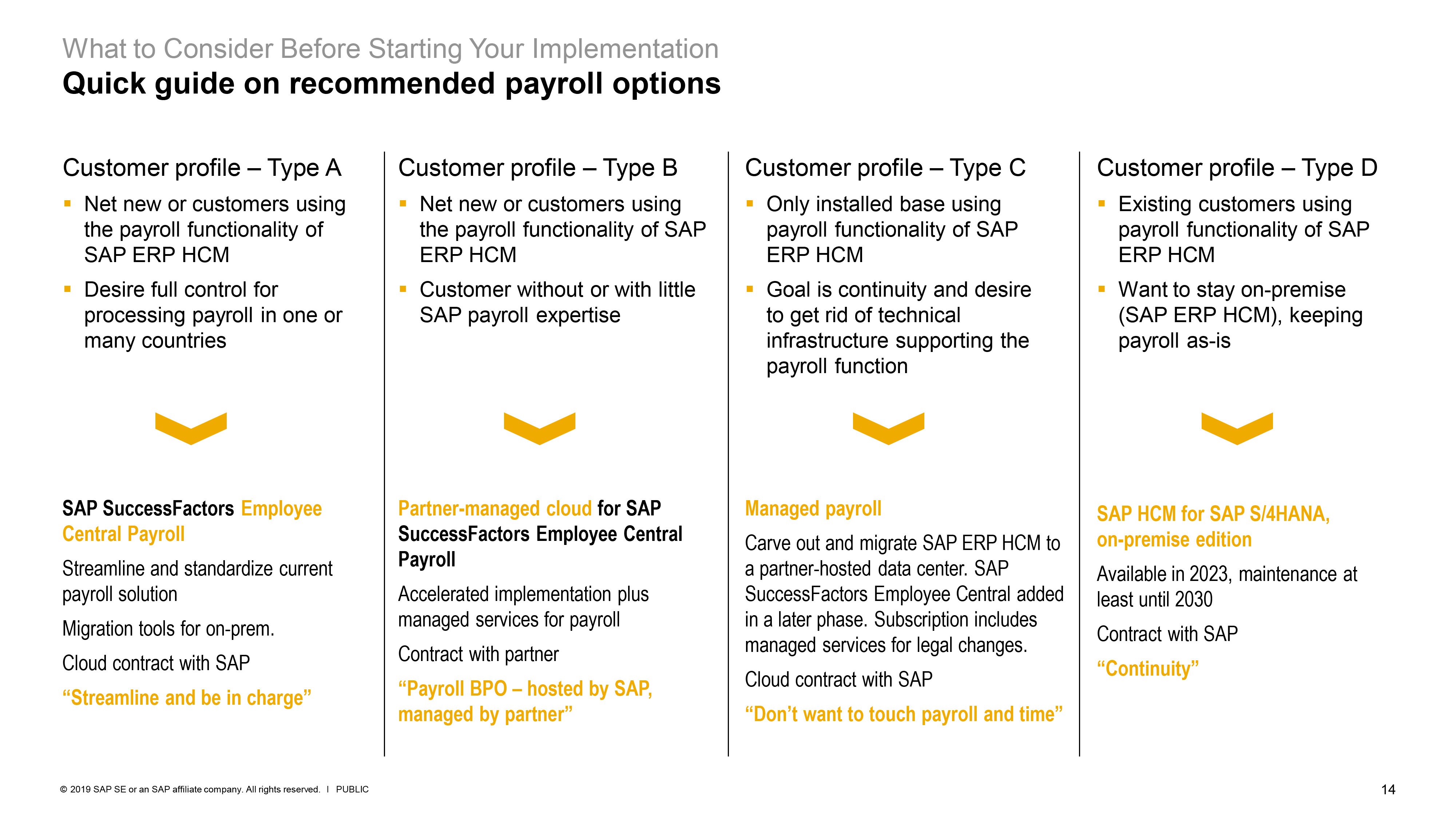 |
The attempts to provide decision trees for customers has evolved, as you can see in SAP’s messaging on the previous page. One message that has remained consistent from the start is that the following customers should not feel an urgency to move to SAP SuccessFactors Employee Central Payroll:
- those who have made a large investment in their Payroll
- those who have a complex or highly customized Payroll
- those with complex time and benefits.
There was a period of time where those customers thought their only option was to move to the Side Car option when it became available in 2023 with a guaranteed support end date through calendar year-end 2030.
SAP makes major changes to their Payroll Offerings in September 2019
At the annual SuccessConnect Conference held in Las Vegas, SAP announced changes that impact existing Payroll Customers, as detailed in this blog. Two of these changes are included below.
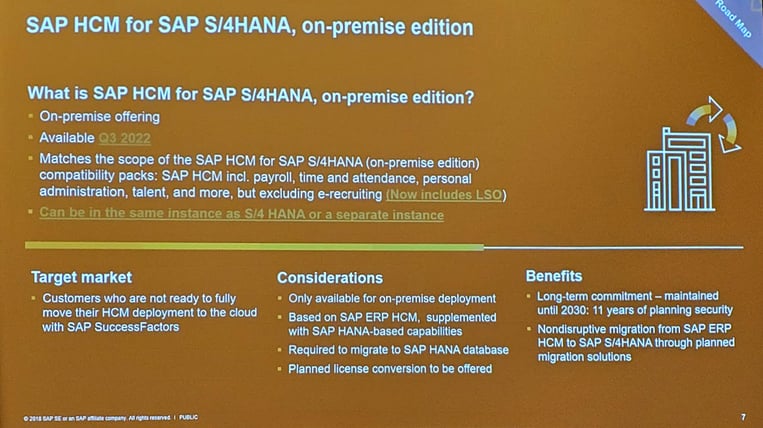
© Source SAP SuccessFactors SuccessConnect 2019 Presentation
The announcement explained that the Sidecar option was no longer a requirement. Customers did not need to carve out their existing HCM systems to move to S/4HANA in those cases where it was embedded within other SAP applications or on the same box.
Instead, customers could leverage an option called SAP Human Capital Management for SAP S/4HANA, on-premise edition. This is not a new option; rather it’s the next evolution of a solution designed to give customers more time to migrate to SuccessFactors and Employee Central Payroll. The recent announcement was focused on a few changes to the original announcement from 2018: the ability to run it single instance, and an earlier availability date.
To summarize:
- SAP HCM S/4 HANA on-premise edition is scheduled to be available two quarters earlier than planned, in 2022 rather than 2023
- SAP HCM for S/4 can be operated within the S/4 HANA Suite and thus follows the general maintenance commitment for the S/4 HANA Suite (beyond 2025 through at least 2030)
- This now includes the LSO offering
- This change has no impact on the SAP SuccessFactors Cloud strategy; SAP still sees this as a bridge solution for customers to move to the cloud by allowing them at least eleven more years of guaranteed on-premise support
- SAP Blog, SAP Human Capital Management for SAP S/4HANA, on-premise edition – Updates: Available in 2022 with a technical co-deployment in SAP S/4HANA here
- SAP News article is updated here.
Accordingly, SAP SuccessFactors shared a vision for Payroll and a new model options diagram, (see below).
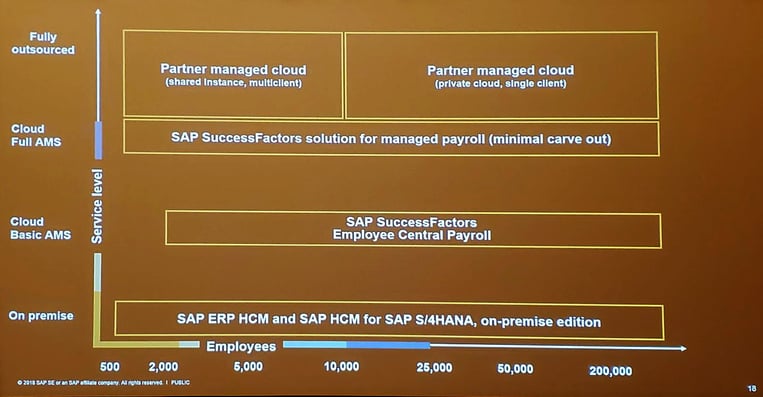
© Source SAP SuccessFactors SuccessConnect 2019 Presentation
2. New Licensing Model
SAP SuccessFactors has also added an option to enable customers who do not use Employee Central (EC) as their core HR system of record to use Employee Central Payroll (ECP) as a standalone deployment. It will require a limited implementation of EC, leveraging the Functional User commercial option.
These changes now bring the number of options for existing SAP HCM On-Premise customers to eight. The last look at the options had six landscape scenarios for customers. With the addition of the new licensing model, that brings us to seven and the option for outsourcing, which has always been available, brings us to eight, as detailed below.
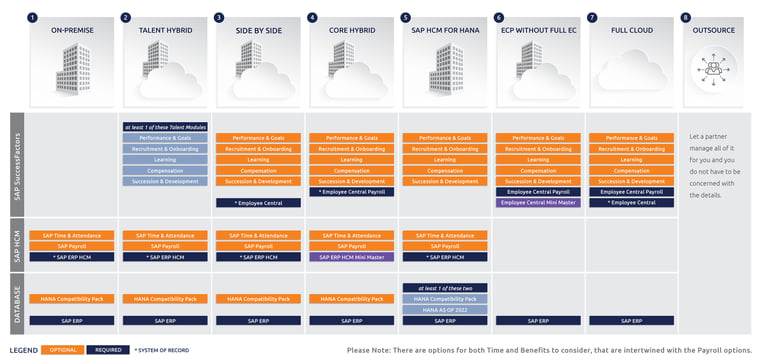
Ultimately, there is no one-size-fits-all solution for SAP’s existing HCM and Payroll customers, as each will have their own requirements, roadmaps etc. to consider. What you can be sure of is that SAP SuccessFactors will continue to adapt along the way to ensure that there is no interruption of your critical HR and Payroll processes, as they have to date, as shown below.

Here at EPI-USE Labs we also made an effort to create a quick reference for the updated options as shown below.
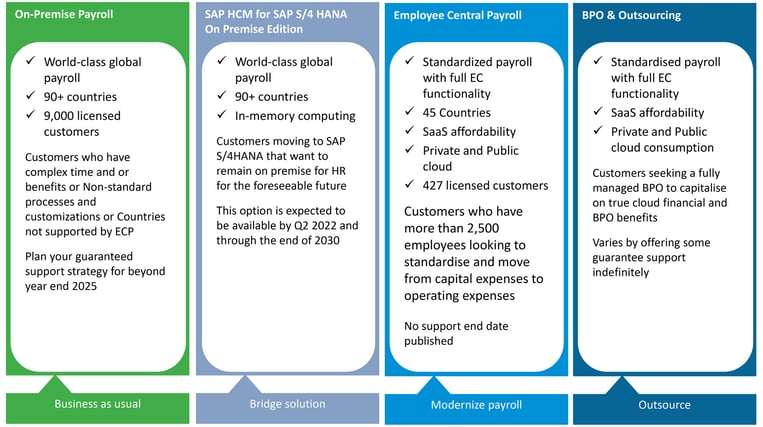
More importantly, EPI-USE Labs is here to help you regardless of which journey you take.
The number of Employee Central Payroll customers doubled from 2018 to 2019

© Source SAP SuccessFactors SuccessConnect
Twice each year, SAP SuccessFactors shares the number of active licenses purchased for SAP SuccessFactors Employee Central Payroll, as shown in the images above. Looking at year-end 2018 and the numbers shared this week at SuccessConnect 2019 in Las Vegas, you can see that the number of customers grew quite substantially.
Employee Central Payroll Customer Growth Model
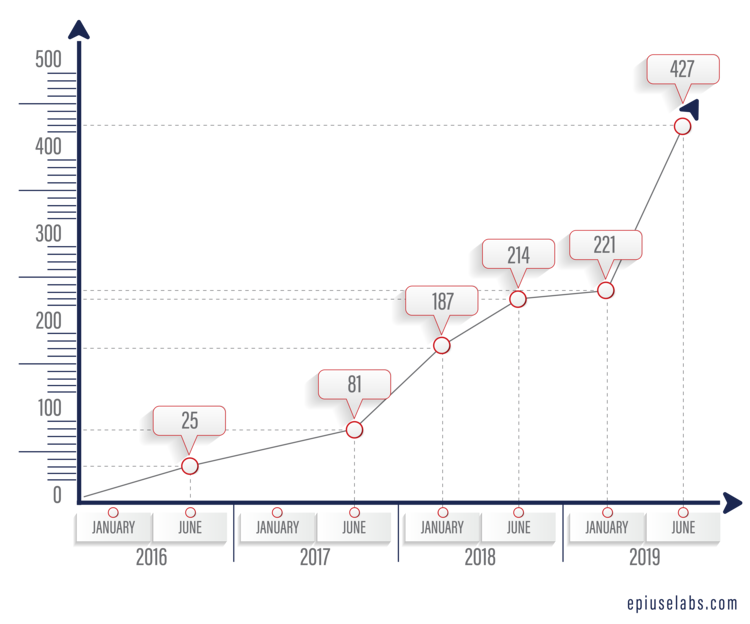
What is not included in those numbers, however, is which percentage of those customers purchasing the Employee Central Payroll solution are net new customers and which percent are conversions from existing customers using SAP On-Premise SAP Payroll.
To speculate a conversion rate estimate and to get an idea of the payroll migration for existing payroll customers, let’s over-generalize and pretend that ALL 427 licenses sold to date for SAP SuccessFactors Employee Central Payroll are conversions from On-Premise SAP. Of course this is not true, but it’s easier from a math perspective. And also let’s assume that there are closer to 7,500 active SAP On-Premise Payroll licenses rather than the published 9,000. That would lend to a less than 6% conversion rate. A conversion percentage that has picked up considerably within the last year, but still has a long way to go.
What I believe contributed to that spike between year-end 2018 and today is:
- SAP has changed direction on Time Management in SuccessFactors
- It's easier than ever before to move from On-Premise Payroll to ECP
- Additional licensing model added.
A) SAP has changed direction on Time Management in SuccessFactors
As originally announced, if customers had complex Time and Attendance requirements, they were not an ideal candidate for SuccessFactors Employee Central Payroll. I specifically recall the messaging from SAP that said that they had no intention to duplicate the complex functionality available in On-Premise SAP Time but rather only offer the simple basics in Employee Central.
In January 2018, SAP shared that approximately 4% of its 14,000 customers had moved from SAP to SuccessFactors with an even smaller percentage making the shift to Employee Central Payroll. As you can imagine, that was certainly a roadblock for many customers with complex Time and Benefits configuration. Shortly thereafter SAP SuccessFactors launched a SuccessFactors Time solution as detailed in my blog titled SAP SuccessFactors launches Employee Central Time Management.
It’s my opinion that this continuing investment in Time Management functionality in SuccessFactors was the first contributing factor to the increase in Employee Central Payroll sales.
B) It's easier than ever before to move from on-premise Payroll to ECP
In the early days many customers viewed the migration from On-Premise SAP Payroll to Employee Central Payroll as a complete re-implementation, which I suspect demotivated many who had made a large investment in their implementation and deployment and who did not wish to consider redoing it.
It does not however require a re-implementation and customers are finding the process uncomplicated and direct. Especially customers leveraging the PRISM migration service offered by EPI-USE Labs which offers a high-speed, low-risk route to SuccessFactors' Employee Central Payroll with no re-implementation required.
We have been doing this type of migration for quite a while now. We here in the EPI-USE family have the expertise and tools to assist customers in migrating their complete history to SuccessFactors' Employee Central Payroll with no re-implementation required via our migration service called PRISM.
PRISM combines leading-edge SAP Landscape Transformation software with world-class SAP Payroll domain expertise. It is a turnkey service to help customers move their On-Premise SAP Payroll to SuccessFactors’ Employee Central Payroll (ECP) quickly and easily, without requiring a full re-implementation.
The reason why it is so easy for us is that we use our SAP-certified tools (Data Sync Manager™ and Variance Monitor™) to surgically carve out a customers Payroll into the SuccessFactors Employee Central Payroll system and provide auditable pay run results, so customers can mitigate risks and reduce payment errors. Data transfer includes client-dependent customizing, custom objects, PA/OM data, PY/TI results, benefits and compensation management. We even offer a Free Assessment that allows you to determine how complex your system is to get you started thinking about your migration.
C) Additional licensing model added, as detailed in the section above.
SAP extends its innovation commitment for SAP S/4HANA, provides clarity and choice on SAP Business Suite 7
On 4 February 2020, SAP announced a maintenance commitment for SAP S/4HANA until the end of 2040. At the same time, SAP promised to provide mainstream maintenance for core applications of SAP Business Suite 7 software* until the end of 2027, followed by optional extended maintenance until the end of 2030.
-1.png?width=763&name=pasted%20image%200%20(1)-1.png)
© SAP 2020
Those of you who have been keeping an eye on this space know that the migration to HANA or S/4HANA has been slower than SAP anticipated. Most general SAP events over the past couple of years have started by asking for a show of hands from customers indicating where they are in their S/4HANA journey.
SAP reports that approximately 13,800 customers have already chosen S/4HANA, with chosen being the key word, while there are a couple of thousand who are actually live or in the midst of an active deployment. DSAG reports that almost half of the attending customers indicated that they plan to migrate to SAP S/4HANA within the next three years. ASUG launched a poll called ‘the Pulse of the SAP Customer 2020’ that asked 625 US customers where they were at, and almost 60% said they were considering it as well.
*Core applications of SAP Business Suite 7 software include SAP ERP 6.0, SAP Customer Relationship Management 7.0, SAP Supply Chain Management 7.0, and SAP Supplier Relationship Management 7.0 applications and SAP Business Suite powered by SAP HANA.
So, what does this mean for Human Capital Management?
SAP’s Ralf Wagner followed up with a detailed blog titled SAP Business Suite 7 Extension: What This Means for SAP ERP Human Capital Management Customers on February 17th. This blog included an updated diagram that shows how long customers can stay on-premise, and it has been updated until 2040 as shown below. The SAP ERP HCM & Payroll are part of the SAP Business Suite 7, so the extension of mainstream maintenance as announced in the press release applies to HCM.
-1.png?width=763&name=pasted%20image%200%20(2)-1.png)
© SAP 2020
What’s interesting is for those customers wanting to keep their current solution beyond 2030, they have the choice of migrating from SAP Business Suite 7 to SAP Human Capital Management for SAP S/4HANA, on-premise edition when it becomes available in Q3 2022.
My impression is that even though SAP advertises their SAP Human Capital Management for SAP S/4HANA, on-premise edition as a bridge solution to give customers additional time to fully move to SAP SuccessFactors, I speculate that they will continue to protect customer investments well beyond the changing dates.
It’s my impression that many companies focus on HCM and payroll last. So their HANA focus or cloud focus has been on areas of the business like Finance and Logistics, and for those customers currently using SAP On-Premise payroll as is, they are taking a “if it ain’t broke don’t fix it” mindset, and will revisit their strategy once the rest of the business plans in the organization are complete.
Summary: April 2020
SAP SuccessFactors has continued to adapt with customers' needs, and their messaging around HCM often starts with a commitment to honor On-Premise investments. The slide shown below is often the first for each HCM-related update, which is used to remind customers that SAP has two investment directions, and that they give both appropriate attention and support.
-1.png?width=763&name=pasted%20image%200%20(3)-1.png)
© SAP 2020
The acknowledgement that SAP may be a “cloud first”, but not a “cloud only” company, is what I believe the existing On-Premise HCM customers really needed to hear. In their summary, SAP included the following:
- They encourage all their 15,000 ERP HCM customers to move to SAP SuccessFactors to accelerate their digital HR transformations
- They also recognize that a subset of their SAP ERP HCM customers will want to run their on-premise environment for the foreseeable future
- Customers’ investments will be protected.
SAP SuccessFactors launches HXM Move
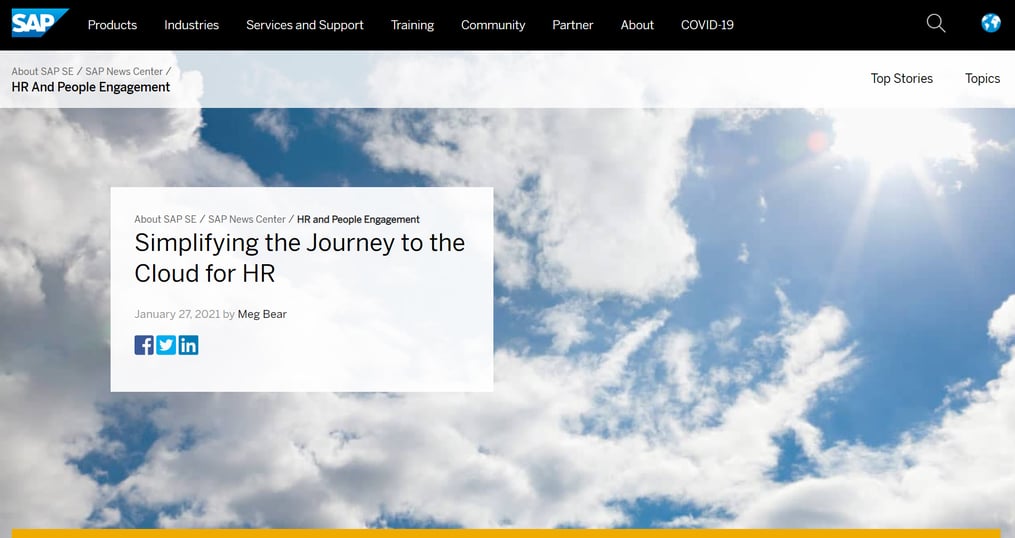
Since the acquisition of SuccessFactors back in late 2011, I have tried to chart the progress and evolution of the SAP SuccessFactors landscape, see below. Over the past several years, SAP SuccessFactors has continually adapted to marketplace feedback which has impacted the offerings available to its customers and the various guaranteed support dates for the solutions, as detailed here.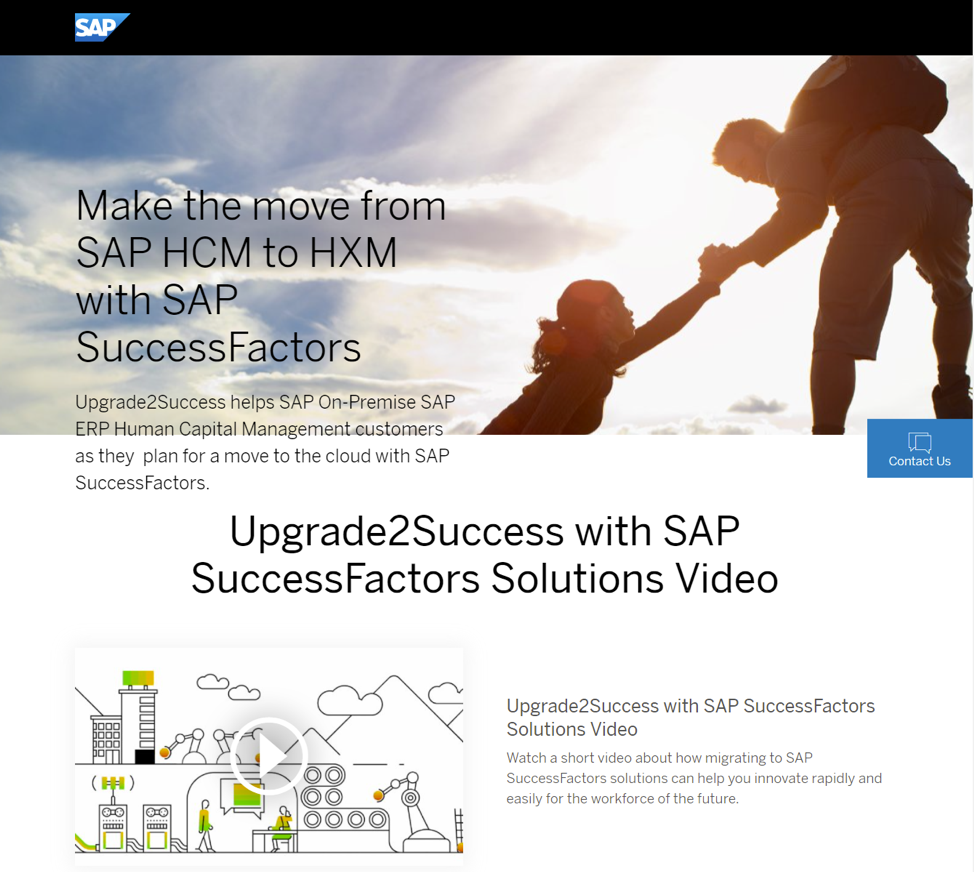
© SAP 2021
The next evolution of Upgrade2Success
HXM Move appears to be the next evolution of the previous campaign called Upgrade2Success. This was the 2019 SAP initiative to encourage customers to move from their On-Premise SAP ERP HCM solution to the cloud described in their free OpenSAP course ‘Upgrade2Success – Making SAP ERP HCM Migration Easier’. That program provided customers with tools, assets and services designed to make their journey easier, and as smooth as possible.
The focus at that time was encouraging customers to move from On-Premise SAP to SuccessFactors Employee Central, including education to assist customers with: data migration, customizations, custom infotypes, and where to find the tools and information to help those thinking of migrating.
At the same time, they also were reminding customers that they had a dedication, from an investment perspective, to both SAP ERP HCM (On-Premise) and SAP SuccessFactors (cloud), as shown in the slide below.
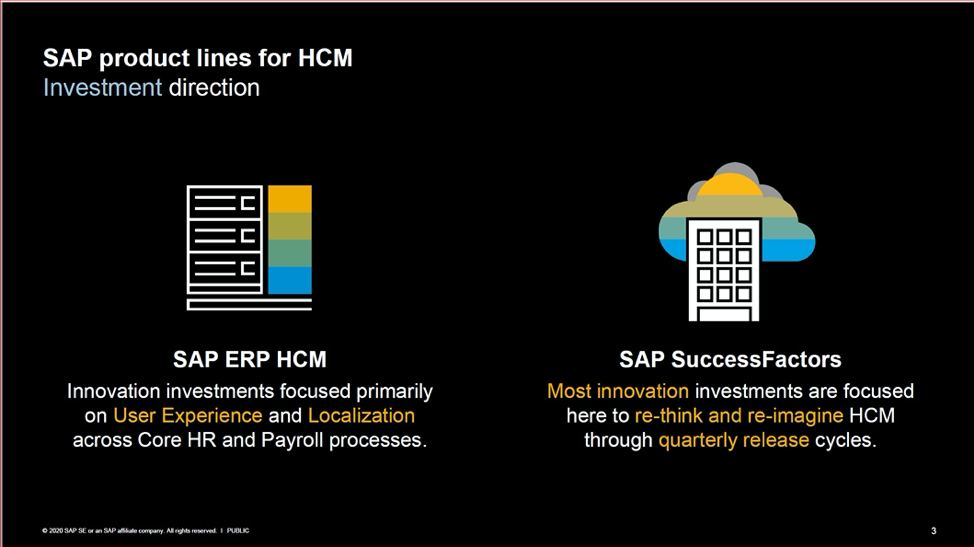
© SAP 2020
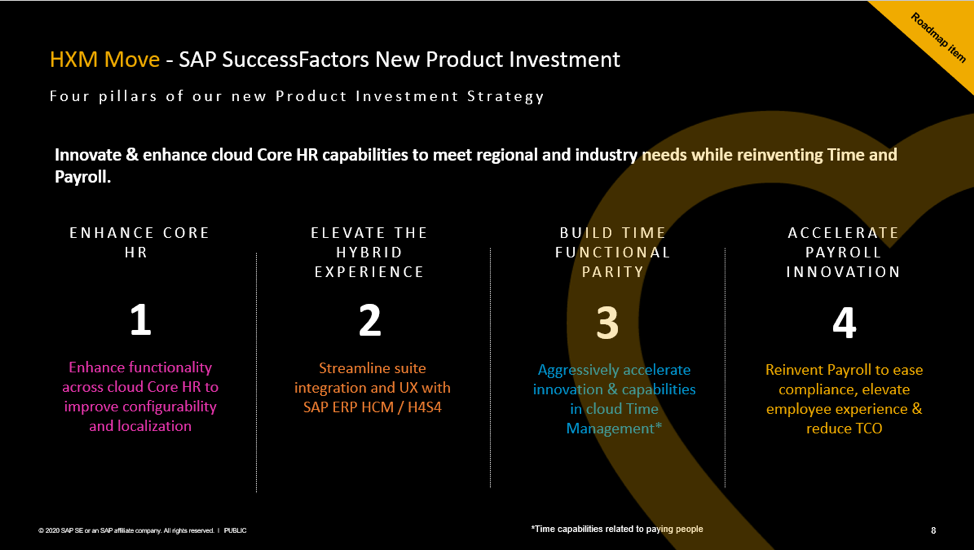
© SAP 2021
HXM Move extends that commitment
As part of the SAP Rise announcement, SAP SuccessFactors confirmed that they will focus on these four key pillars from an investment strategy beginning in 2021. These four key pillars are at the heart of HXM Move:
- Enhance core HR
- Elevate the hybrid experience
- Build time functional parity
- Accelerate Payroll Innovation
1 - Enhance core HR
This pillar is to enhance SuccessFactors Employee Central with a special focus on functionality, configurability and localization including compensation administration (collective bargaining agreements), personal data management (dependents) and the ability to process mass organizational changes.
2 - Elevate the hybrid experience
Hybrid customers are using at least two systems for the processing of their People or Payroll data, and the goal with this pillar is for customers to experience it as a single one-system experience, including a guided experience for managers, employees and HR administrators for processes that span across systems. Another part of this is a concentration on process orchestration that allows flexibility to adapt to changes throughout an employee’s entire life cycle, and to ensure that there is a smooth flow of data, from hiring to paying an employee, including validations and alerts to ensure data quality. EPI-USE Labs’ focus for our hybrid clients has been on ensuring that they are aware of the seven critical functions that they need to keep an eye on in this landscape.
3 - Build time functional parity
I have written a few articles and blogs on Time Management including my thoughts on the initial launch of SAP SuccessFactors Employee Central Time back in 2018. You may recall that there was a period of time when SAP SuccessFactors encouraged customers to use partners for the management of time in tandem with SuccessFactors, as seen on their slide below which many saw as a departure from what SAP is known for. SAP Payroll, fueled by SAP Time Management and Evaluation, is indeed the ‘secret sauce’ that keeps their approximately 8,500 on-premise Payroll customers going every day.
The pivot to the development of Time in SuccessFactors and the mention that they may consider replicating the type of robust functionality available in ECC time is interesting to customers who are using their complex Time Management deployment as an excuse to stay on premise for Payroll. The commitment to Time in the cloud and to accelerate innovation and capabilities aggressively in cloud time tracking is an item we should keep an eye on. For clients interested in leveraging mobile timesheet functionality and light rostering today, EPI-USE Labs offers GeoClock.
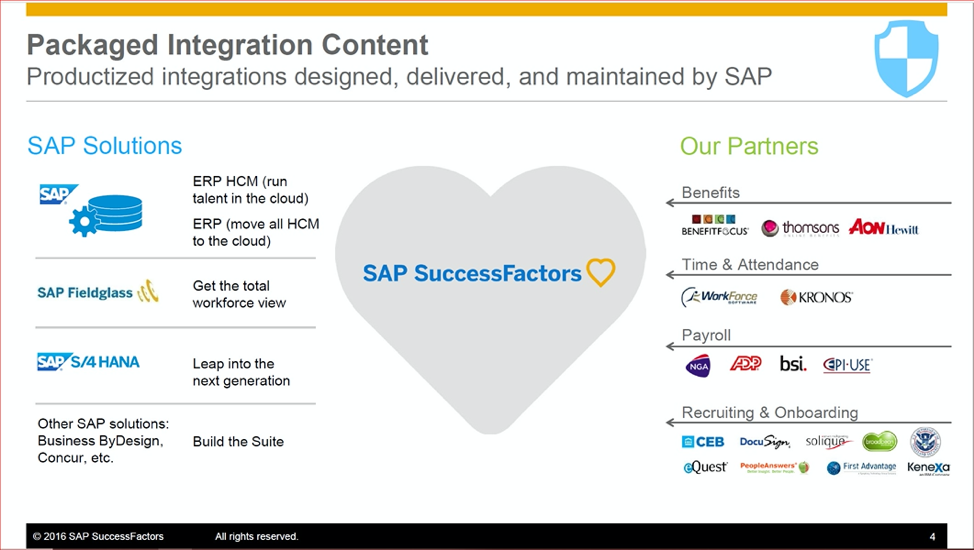
© SAP 2016
4 - Accelerate Payroll Innovation
The final area of investment for SAP SuccessFactors is on the acceleration of Payroll Innovation. SAP currently offers the leading Payroll solution used by many of the largest organizations in the world to process millions of employees' pay accurately and efficiently. This continued dedication and focus on Payroll includes SAP’s commitment to continued development on their next level Payroll Innovation in the cloud. More to come on that in the near future.
It is no secret that existing customers are wedded to their On-Premise SAP Payroll and will be keen on the new options announced as part of HXM Move, including the new S/4HANA Private Cloud Edition (PCE). This new option gives existing SAP Payroll customers an innovative way of managing their HR, Payroll Time and/or Benefits, via a cost-effective pathway to the cloud, while retaining the functional richness of their SAP Payroll system run on an S/4HANA system. At EPI-USE Labs, we provide an accelerated solution for customers looking to take advantage of this new offering called PRISM for HCM (Private Cloud Edition) .
SAP SuccessFactors announces new licensing model SAP S/4HANA Private Cloud Edition (S/4 PCE) for HCM
SAP has announced the HXM Move program to make it easier for on-premise customers to move to the cloud. They have made it clear that the SuccessFactors HXM suite is the go-forward HR solution for innovation and digital transformation, and is the focus of the HXM Move program, yet with their announcements over the past few years they have recognized that customers will continue to have hybrid models and may want to simplify their existing landscape without large-scale change.
Over the past few years, SAP has adapted to marketplace feedback which has impacted the offerings available to customers and the various guaranteed support dates for the solutions.
The launch of the SAP S/4HANA Private Cloud Edition (S/4 PCE) is another option designed to empower customers to get the most from their current investment, while reaping the benefits of a flexible and non disruptive first step to the cloud.
Will S/4 PCE for HCM suit you?
If you are an existing on-premise HCM or Payroll SAP customer, S/4HANA Private Cloud Edition (PCE) may suit you if you:
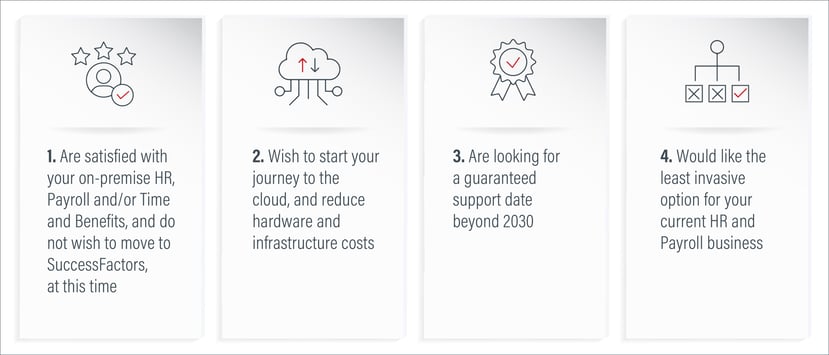
What does it entail?
If you select SAP S/4HANA Private Cloud Edition (S/4 PCE) you would commit to doing two things:
-
Purchasing an SAP S/4HANA Private Cloud Edition (S/4 PCE) license which moves your environment to SAP’s own data center or in a hyperscalar (Azure, GCP, AWS).
-
Migrating your system to S/4HANA.
What are the benefits of S/4HANA Private Cloud Edition for HCM (S/4 PCE for HCM)?
This is a non-disruptive way to keep your HR, Payroll Time and/or Benefits via a cost-effective pathway to the cloud, while retaining the functional richness of your existing systems.
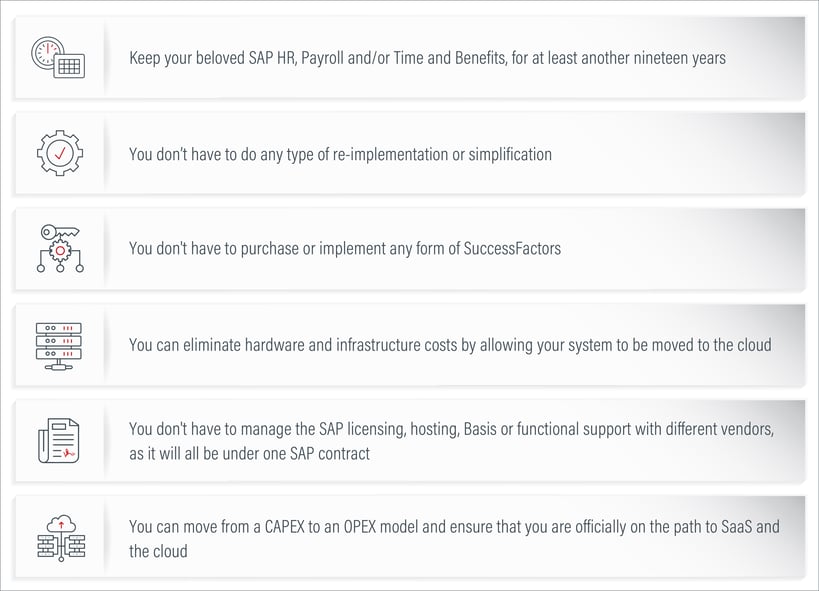
So can I keep my Payroll and/or Time and Benefits as is, indefinitely?
Nothing is indefinite, but what SAP SuccessFactors has committed to is that the guaranteed support date currently aligns with the S/4HANA support date, which is until calendar year-end 2040, see below.
How long will it take me to move to PCE, and what will it cost?
There is no one-size-fits-all answer for every customer, but I’m happy to share that as a valued SAP SuccessFactors Partner, EPI-USE Labs has a proven solution to make it easier for customers to transition to S/4HANA Private Cloud Edition (PCE).
EPI-USE has been doing carve-outs since at least 1998, and over the past several years we have modified that technology to support different variations on the HCM side including SAP SFSF Managed Payroll , and our popular migration solution for customers moving to SuccessFactors Employee Central Payroll called PRISM, so it was not a big jump for us to offer it for S/4HANA.
You might already be familiar with PRISM. PRISM is our rapid deployment solution with a methodology of Transformation without re-implementation, as featured on SAP’s App Center. The solution allows our clients to engage in a high-speed, low-cost transformation leveraging SAP-certified solutions, a distinction that makes us unique in this space.
Our clients have been leveraging the PRISM for HCM (Employee Central Payroll) solution to migrate from On-Premise SAP Payroll to SuccessFactors Employee Central Payroll. See our success stories from PostNL and North American Lighting.
PRISM for HCM (Private Cloud Edition)
Our solution can dramatically reduce your project time by directly moving the configuration and data without requiring the typical S/4 upgrade steps and downtime. Furthermore, we mitigate the risk by offering parallel testing between the source and target environments by means of post-migration testing services that use our SAP-certified products. All this can be
accomplished within a minimum amount of time. We have prepared a quick video outlining how it works (see below).
As SAP mentions in their press release: “Business transformation is no longer an option; it’s imperative. Thriving in today’s economy demands more agility, greater insights, and more dynamic experiences. In making the market for HXM, we are enabling the next evolution of HR where people are at the center of business. This is only possible with the innovation and flexibility provided by the cloud. With HXM Move, we are partnering with our customers to make the technology changes they need to future-proof not only their business transformations, but their people transformations.”
SAP HCM for S/4HANA On-Premise (H4S4) will become available in Q4-2022
Ralf Wagner announced in his blog titled SAP Human Capital Management for SAP S/4HANA, on-premise edition – Available in Q4 2022 as part of the SAP S/4HANA release back in 2019 that another option would become available for customers in 2022. That offering has been renamed to SAP HCM for SAP S/4HANA On-Premise (more familiarly known as ‘H4S4’). This is another variation, similar to the SAP S/4HANA Private Cloud Edition (PCE) offering, for customers who wish to extend their current investment in SAP ERP HCM. As opposed to the PCE offering, H4S4 allows continued use of the on-premise SAP® talent solutions, including learning and recruiting (subject to licensing). It will be available in Q4/2022, synced with the SAP S/4HANA release, and can be deployed either within the SAP S/4HANA environment or run standalone. More details will become available in 2022 as the delivery date approaches. Commercial details are not yet available.
Will H4S4 suit you?
If you are content with your current SAP ECC On-Premise HCM system (including Payroll, Benefits, Time and Talent solutions) and are not looking to move to the cloud just yet, this will be the option with the least amount of disruption and also the least amount of new innovation (with the exception of HAN database performance optimizations). It is essentially business as usual, with guaranteed on-premise support through calendar year-end 2040.
What does it entail?
- A technical upgrade/migration to S/4HANA
- A license change from named users to a subscription
2022 SAP SuccessFactors Payroll Options
Starting in 2022, SAP customers will have four options for world-class SAP Payroll as detailed in the table below.
| Option | Payroll | Description | Learn more |
| 1 | SAP ERP HCM Payroll On-Premise | Business as usual SAP SuccessFactors has given a commitment to their approximately 9,000 on-premise SAP Payroll customers that they will not experience an interruption in their continuous world-class support, guaranteed until calendar year-end 2027, with extended support available until 2030. |
SAP Business Suite 7 Extension: What This Means for SAP ERP Human Capital Management Customers |
| 2 | SAP S/4HANA Private Cloud Edition (PCE) | Non-disruptive pathway to digital transformation This offering, aligned with the HXM Move program, is part of SAP’s continued commitment to helping customers continue to get ROI from their on-premise SAP investment, while creating a bridge to the cloud and the future. This is a non-disruptive way to keep your HR, Payroll Time and/or Benefits via a cost-effective pathway to the cloud, while retaining the functional richness of your existing systems. This option involves migrating to an SAP S/4HANA Private Cloud Edition (S/4 PCE) subscription, moving your environment to SAP’s own data center or a hyperscalar (Azure, GCP, AWS). A conversion from on-premise SAP ERP HCM licenses to PCE cloud subscriptions is also required. |
Migrate your HCM on-premise to S/4HANA Private Cloud Edition (PCE) |
| 3 | SAP SuccessFactors Employee Central Payroll | Innovation The current focus of innovation with approximately 850 customers and 48 local versions. SAP also allows partners to build their own with partner localizations. Customers running SAP Payroll (on-premise) who wish to move to SuccessFactors Employee Central Payroll (ECP) can do so using tools provided by SAP and partners. Employee Central is a prerequisite to deploying ECP. |
Migrate on-premise Payroll to SuccessFactors’ Employee Central with PRISM for ECP |
| 4 | SAP HCM for S/4 HANA On-Premise (H4S4) | Available in Q4 2022 An offering for customers who wish to extend their current investment in SAP ERP HCM. As opposed to the PCE offering, H4S4 will allow continued use of the on-premise SAP® talent solutions, including learning and recruiting (subject to licensing). It will be available in Q4/2022, synced with the SAP S/4HANA release and can be deployed either within the SAP S/4HANA environment or run standalone. |
EPI-USE Labs will offer an upgrade path to H4S4 once it becomes available. We will probably leverage our Data Sync Manager™ (DSM) technology, and create a PRISM offering and methodology to reduce risk and increase the speed at which an upgrade can occur. |
SAP HCM for S/4HANA On-Premise (H4S4) is made available
SAP has continued to emphasize that all of the exciting innovation is happening in the SAP SuccessFactors Human Experience Management (HXM) suite. SAP SuccessFactors Employee Central has crossed over 5,000 customers, including more on-premise customers making the move each quarter. However, there are still customers on the journey to get there. Based on feedback, SAP understands that there will be many customers who continue to operate in a hybrid environment (Cloud and on-premise deployments). These customers want their current SAP HCM investments to be protected, and to have additional time for a full cloud migration – which is the reason for the various options.
SAP S/4HANA Private Cloud Edition (PCE)
For customers who do not want to change their existing business processes while moving to a private cloud infrastructure, SAP S/4HANA Private Cloud Edition (PCE) is the recommended and least disruptive pathway to keep your HR, Payroll, Time and/or Benefits functionality, especially as most customers are looking at moving away from on-premise deployments.
This allows a cost-effective pathway to the cloud, while retaining the functional richness of your existing systems. This option involves migrating to an SAP S/4HANA Private Cloud Edition (S/4 PCE) subscription, moving your environment to SAP’s own data center or in a hyperscalar (Azure, GCP, AWS). A conversion from on-premise SAP ERP HCM licenses to PCE cloud subscriptions is required. More info is available at Migrate your HCM on-premise to S/4HANA Private Cloud Edition (PCE).
SAP Human Capital Management for SAP S/4HANA (H4S4)
H4S4 is not a completely new on-premise HCM solution. It’s a continuation of the existing HCM code line (in a new on-premise deployment that is part of SAP S/4HANA 2022) that has existed within ECC, and R/3 three before it, as detailed years ago in this blog: SAP Business Suite 7 Extension: What This Means for SAP ERP Human Capital Management Customers. Even though it has a new name and is commercially available, H4S4 does not represent a change in SAP SuccessFactors overall HR strategy or roadmap.
There are some delivered enhancements, primarily as a result of HANA adoption (which are also available in SAP S/4HANA Private Cloud Edition). This is what you need to know about H4S4:
- It is an on-premise offering that requires customers to maintain their own infrastructure
- The scope largely matches what’s in the Compatibility Pack today, although not every single function that is available today gets carried forward (some will be deprecated, see https://launchpad.support.sap.com/#/notes/3091160). Only the more recent components are supported (for example, PA-CM is being deprecated in favor of PA-EC).
- It does support all of the local payroll versions
- It is designed as a continuity plan for customers who need extra time to move to SAP SuccessFactors and still need or want to maintain on-premise infrastructure.
The dates relevant for SAP HCM customers
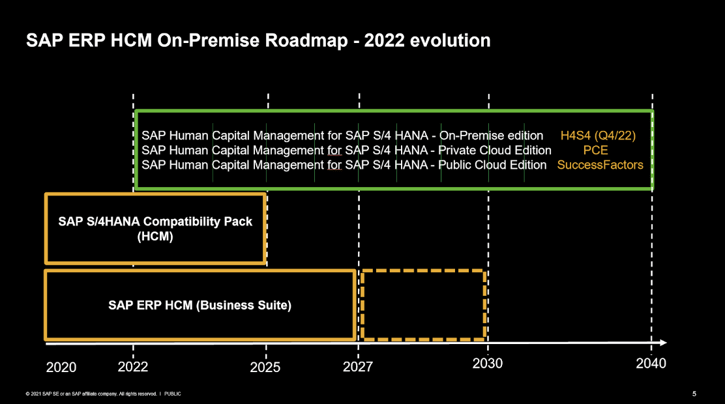
SAP HCM Relevant Dates
From a transition perspective, there are a few dates that everybody needs to keep in mind when considering what to do with their current implementations.
| 2025 | The first date is 2025. Calendar year-end 2025 is when the usage rights for Compatibility Packs expire. If you’re not familiar with Compatibility Packs, it is the ability for the customer to run the ECC code line and the S/4HANA code line in the same instance. Any S/4HANA customers running on the Compatibility Pack and running the existing HCM code will need to be off of that by the end of 2040. All usage rights expire after that for the HCM code line. As a result of already running SAP S/4HANA, these customers will be able to migrate to PCE or H4S4 more easily. |
| 2027 & 2030 | If the customer is running SAP ERP HCM, calendar year-end 2027 is the end of mainstream maintenance with an option for customers to pay slightly more for extended maintenance up until year-end 2030. |
| 2040 | On February 4, 2020, SAP announced an innovation commitment for SAP S/4HANA until the end of 2040. This means that until calendar year-end 2040, there will always be at least one release of SAP S/4HANA in maintenance which is relevant for both H4S4 and PCE. With the subscription contract model of PCE, the agreement is until the contract dates including any renewal clauses. |
| No end date | SAP SuccessFactors HXM Suite |
The decision for H4S4 is largely based on whether the customer wants to stay on-premise
- If an S/4HANA customer wants to remain on-premise and continue running the HCM functionality, they must purchase and migrate to H4S4 based on the dates shared earlier.
- If an S/4HANA customer is already running on PCE, they can adopt H4S4 at any time, so long as they are running the S/4HANA 2022 release.
Net: For PCE customers, H4S4 is basically just part of the S/4 release adoption; on-premise customers have to purchase it separately.
Note that if a customer is already running S/4 Comp Pack, the move to H4S4 will be non-disruptive; if they are moving from ECC, they will still need to adopt HANA as the DB which is a larger project.
Customers leveraging bridge options will need to migrate to the HANA database
With most CTOs looking to move off on-premise infrastructure, most customers would be likely to consider a move to PCE before continuing with an on-premise offering such as H4S4, especially considering they can keep their existing business processes as-is.
If customers do consider H4S4, they can run it either embedded, as a single instance, or on a separate SAP S/4HANA instance, which are the same setups customers have today. Customers will need to license H4S4, which will require a commercial conversion from their existing system. There are a series of new material codes that were released such as core HR, time management, and Payroll. There is also a new one for BSI if the customer wants to run U.S. payroll. There are also ones for Learning Solution (LSO) and E-recruiting that enable on-premise customers the continuity to leverage those, as they are today.
To use the H4S4 option customers will need to update to an SAP S/4HANA environment. It is an upgrade-like conversion and there are migration tools available. For those customers running Compatibility Packs today, it is essentially a continuation of the Compatibility Pack.
The delivery of H4S4 was shipped with the SAP S/4HANA 2022 release. Customers implementing S/4HANA 2022 who have licensed it will have access to the H4S4 solution. It gives these customers standard maintenance until 2040.
Commercial Differences
An important difference is in the old world, SAP sold named users. In the new world, they sell engines. The reason for that is it greatly simplifies things, because they no longer have to deal with named users and a combination of the payroll engine. The real benefit of this is it sets the customer up for a much easier commercial migration and transition into SAP SuccessFactors.
This works via a one-to-one correspondence, Core HR, Time, Payroll, Learning and Recruiting over to SuccessFactors when the customers are ready. Conversion credits according to all of the standard SAP S/4HANA transition options are available as well. So the customer can take some of the licenses they’ve already been using, the maintenance they’re paying, and then they can convert those over to the H4S4 license. Because it has to be licensed, a commercial transaction does need to be executed. There are prices associated with that; however, there are some conversion credits allowed. In some cases, customers will likely have to pay more, especially those who are not fully licensed for self-services. Essentially, all employees who will be managed in the system will be licensed in this model. Only the on-premise customers will have to execute a commercial transaction to get this.
There is also a Private Tailored Option (PTO) which is to accommodate for the old HEC option; those customers will not have to pay again. PTO is the successor to HEC, and both PCE and PTO customers will get the H4 solution available to them as part of the subscription.
Comparing PCE versus H4S4
Customers who feel that they cannot move to SAP SuccessFactors Employee Central Payroll for localization or functionality reasons often find themselves reviewing these two options. I have put the main differences in the table below.
SAP announces that they are building a Next Gen Cloud Payroll
SAP SuccessFactors announced that their next generation payroll has a name: SAP SuccessFactors Payroll, which you may hear shortened to SFPAY. It’s been in the works for several years, and as SAP would say, they continue to innovate in every area including payroll.
SAP Payroll is the leading global payroll. It has been the consistent standard for organizations since the 1980s, and it is the only one that can handle complex payroll and time, especially globally. There are thousands of clients around the world using on-premise SAP Payroll or SAP SuccessFactors Employee Central Payroll to process over 100 million of employees' pay statements each month. The recommended solution for clients is SAP SuccessFactors Employee Central Payroll, which is where all the innovation exists (such as their AI Joule), and will be the gold standard for many years to come.
SAP SuccessFactors Payroll (SFPAY) is an exciting option that will be coming to market in the next few years. However, it is an early adopter innovation available to smaller and simpler clients, starting in the UK and then the US. The launch target market does not overlap with the type of clients using, or who would consider, an SAP-based payroll system today; and it will give clients who could not previously consider an SAP-based payroll system an amazing option.
A few early adopters in the US and UK are participating in the design evolution and early testing to provide feedback to SAP on what a modern cloud-native payroll should do (such as a real-time payroll, interactive pay statements, simpler set-up, modern integrations with other systems, and much more).
So, should you wait for it if you use an SAP based payroll system today? That's an easy no. Rome wasn’t built in a day, and neither was SAP Payroll (or any enterprise payroll system for that matter). The beloved payroll that is in use today has been in use and evolving for over thirty years; and it continues to evolve and get investment from SAP.
SAP SuccessFactors is consciously building a new payroll from scratch that runs in the cloud. It will allow them to expand their market share, and do some very innovative things in payroll, and we are all really excited about it. But it is not going to be readily available anytime soon for existing clients using SAP payroll, and clients should not wait for it to be built before making a change.
SAP has made it clear that innovation will only be in the cloud. The slide that they have been showcasing for customers since 2012 (scroll up to see it) that shows their multiple areas of investment every year has now been simplified to only two options, as shown below, which they have rebranded to Innovation and Continuity.

The message to customers has evolved from ‘move at your own pace’ to ‘Cloud first but not cloud only' to ‘If you want innovation - the Cloud is the only place you will get it’. In other words, clients that select to extend maintenance or choose a continuity option like H4S4 will not get the benefit of any new technology, which includes AI and Joule as described in these articles.
SAP Move to the Cloud
SAP launches the Customer Evolution Program
The SAP Customer Evolution Program for HCM is a strategic initiative by SAP to help Human Capital Management (HCM) customers transition from their existing on-premise solutions, such as SAP ERP HCM, to the cloud-based SAP SuccessFactors suite. This program is part of SAP’s broader effort to modernize its customer base by encouraging the adoption of more scalable, innovative, and future-proof cloud solutions.
The program includes new assets for customers to accelerate their migrations and their relaunched Readiness Assessment as described in Get a free tool for your HCM Digital Transformation to SAP S/4HANA and/or cloud.

SAP has made it easier for customers to understand the benefits of a digital HCM transformation, including this Top 10 reasons diagram shown below.

Keeping an eye on SAP customer migration
After a successful annual event (see highlights in My SuccessConnect 2024 Recap: Core HR, AI and the Cloud), all eyes are on SAP SuccessFactors to see how many of the approximately 9,000 on-premise HR customers will move to SAP SuccessFactors Employee Central Payroll, and at what pace.
Our clients come to us for guidance to make and defend their business decisions and deploy them with confidence while operating in a continually evolving climate.
An Update to the HCM Payroll Bridge options for SAP SuccessFactors clients: Part 3
SAP has announced a new offering designed to assist customers navigating for the largest, most complex deployments. This initiative aims to support organizations transitioning from on-premise SAP ERP systems to modern, cloud-based solutions while optimizing business processes and enhancing agility.
For Human Capital Management (HCM) and Payroll customers, this transformation specifically involves migrating from on-premise SAP ECC HCM and Payroll to SAP SuccessFactors Employee Central and Employee Central Payroll in the cloud. Since SAP first introduced its migration strategy, many customers have proactively embraced innovation and accelerated their journey to the cloud. The urgency surrounding this shift is further outlined in SAP’s blog on the SAP Business Suite 7 extension and its implications for HCM clients.
SAP SuccessFactors has remained committed to its existing customer base by offering extended timelines and flexible options to ensure organizations maximize their return on investment. This commitment is detailed in SAP’s discussion on bridge options for SAP SuccessFactors clients, including insights into SAP HCM for S/4HANA On-Premise as an interim solution.
While the introduction of this new transition option provides additional flexibility, it is unlikely to significantly alter most HCM customers' cloud migration strategies. The ultimate destination remains SAP SuccessFactors Employee Central Payroll, with this offering serving as a specialized solution for organizations with particularly complex requirements.
What is SAP ERP, Private Edition, Transition option?
SAP is introducing a new cloud subscription offering intended only for large-scale and complex systems centered around SAP ECC, accompanied by a suite of dedicated services designed to support the transition to SAP cloud ERP. This solution will also ensure business continuity by providing security, legal, and software patches. Customers will be able to purchase the offering starting in 2028, with availability for use between 2031 and 2033.
SAP is announcing this in advance to accommodate customers with complex IT landscapes, ensuring they have ample time to plan accordingly.
This offering is entirely optional. Customers who complete their transition to SAP cloud ERP by the end of 2030 will not require it. The SAP ERP, private edition, transition option, is specifically designed for those who need additional time and assistance in their journey.
Key details include:
- The offering will focus on SAP ECC and will not cover the full SAP Business Suite 7, which remains available for subscription only until the end of 2030. SAP will clarify the scope of eligible products later this year.
- Systems intending to leverage this transition option must be migrated to SAP ERP, private edition, before the close of 2030.
- Subscribing to this offering between 2031 and 2033 will require specific preparations, including the exclusive use of SAP HANA as the supported database and additional adjustments due to the discontinuation of older third-party technologies, such as certain Java versions.
Further details will be disclosed as the 2028 purchase availability date approaches. The recommended path following this offering will be a full transition to SAP cloud ERP.
It is important to note that this is not an extension of SAP ERP maintenance, and there are no changes to the roadmap for on-premise SAP ERP systems beyond 2030.
The SAP ERP, private edition, transition option will be available at a higher cost in 2031-2033 compared to an equivalent ERP cloud subscription before 2031. Additional details will be shared during the broader launch in Q2 2025 and as the contractual availability date in 2028 approaches.
Start with an Assessment
If you are not sure which option is best for you, you can start with an assessment that will provide you the intel you need to make the best decision for your unique business requirements. Learn more at Get a free tool for your HCM Digital Transformation to SAP S/4HANA and/or cloud.
Find out more about your SAP HCM & Payroll options
EPI-USE Labs solutions have universal value regardless of your landscape model to help you get the most out of intelligent HR and Payroll.
Get maximum ROI from your SAP HCM investment: HCM Productivity Suite
The HCM Productivity Suite is a packaged suite of solutions for your SAP HCM system to help you achieve maximum ROI for your SAP HCM investment, both on-premise and in SAP SuccessFactors.
DISCOVER HCM PRODUCTIVITY SUITE
Moving to S/4HANA? Try this free assessment
PRISM, your high-speed, low-risk route to modern SAP landscapes, brings you a combination of powerful software and SAP® domain experts that can accelerate your move to S/4HANA. EPI-USE Labs has the proven software products including Data Sync Manager and Variance Monitor to facilitate a painless and automated migration whilst EPI-USE has the world’s best Payroll consultants to migrate the Payroll.
READ ABOUT PRISM  PRISM FOR HCM (S/4 PRIVATE CLOUD EDITION) PRISM for ECP
PRISM FOR HCM (S/4 PRIVATE CLOUD EDITION) PRISM for ECP
Solve your biggest SAP HCM Challenge… Reporting
A big challenge for SAP On-Premise HCM customers is that you need multiple tools to report on critical HR and Payroll data. Often this data is collected via these tools and consolidated offline, taking manual effort and posing security and data integrity risks. Query Manager™ solves this challenge by providing access to all of the data you need in an easy-to-use format, so you can be empowered to create reports on your own, live in SAP, without reliance on technical resources.
Work with your SAP HCM data live in Microsoft Excel
With Query Manager’s Microsoft Excel Add-in, you can refresh, analyze, share, and present your critical SAP HCM data, live in Microsoft Excel. What is unique about this web app is that once you have built an Excel worksheet with all the formatting and formulas that you need, you can simply click a button to refresh your spreadsheet with live data from SAP.
EXPLORE MS EXCEL ADD-IN FOR QUERY MANAGER
Generate richly formatted documents and employee letters automatically
Employers send thousands of letters to employees each year such as Benefits Confirmation Statements, Employee Paycheck Explanations, Total Compensation Statements, Annual Review Letters. The manual creation of these letters is time-consuming and error-prone. Document Builder enables you to design, generate and distribute professional HR documents automatically, live from your SAP HCM system.
GET INFO ABOUT DOCUMENT BUILDER
Highlight inconsistencies in your ever-changing HCM data
Variance Monitor gives you the ability to compare HR and Payroll data between systems and across periods. And because it’s automated, it eliminates manual comparisons, speeds up your processes and enables your managers and test teams to be much more productive.
SEE HOW VARIANCE MONITOR WORKS
Enjoy convenient, secure copying of SAP HCM data
Data Sync Manager™ (DSM) for HCM empowers all SAP HCM users to copy and scramble HCM production data in non-production systems for testing, training and support. This SAP-certified solution allows you to select and transfer specific HCM data objects easily and accurately, as needed, and to mask sensitive data for confidentiality, security and governance compliance.
HOW CAN DSM FOR HCM HELP YOU? FIND OUT
Report across both On-Premise SAP and SuccessFactors
Query Manager’s Add-on for SuccessFactors Integration allows you to report on data from both your On-Premise SAP system and your SAP SuccessFactors solution. SuccessFactors data is available as a data source in Query Manager, so it can be combined with any data in SAP, or any external system. So clients who have some of their data in an On-Premise SAP system and some in the SAP SuccessFactors system, can extract data from both systems to run consolidated reports.
